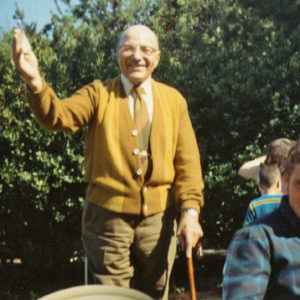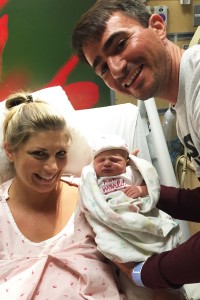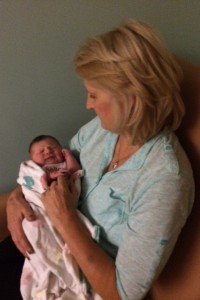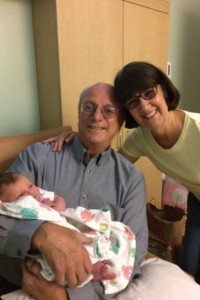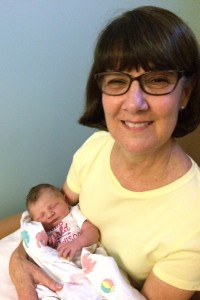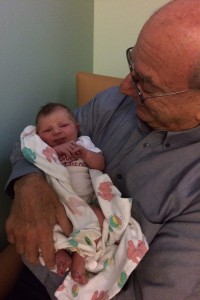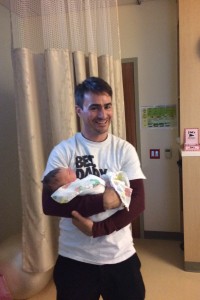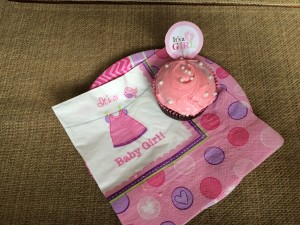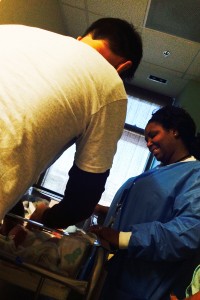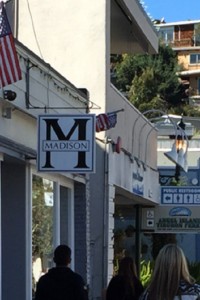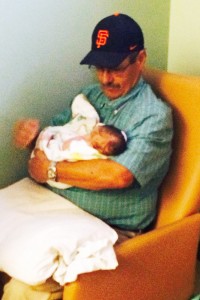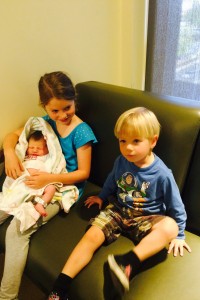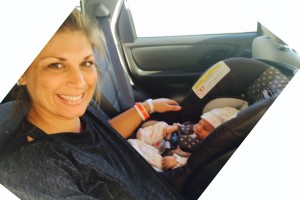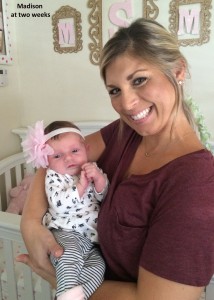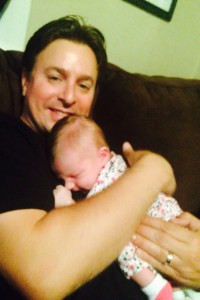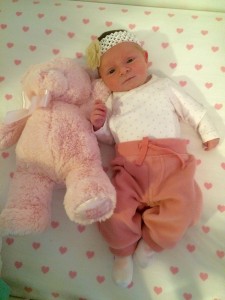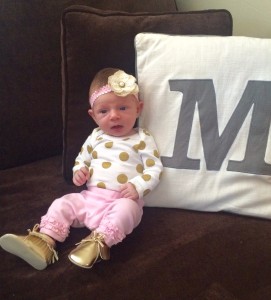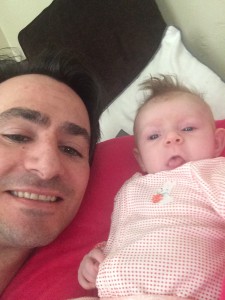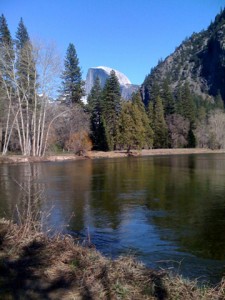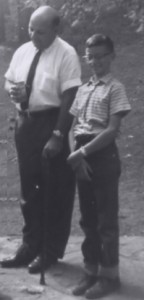Archive for Family Stories
Breaking News: Chelsie Has A New Nest
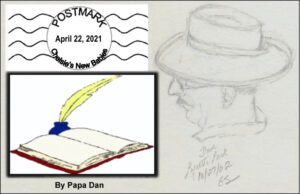
Remember the first episode of our
Hummingbird Story from back in February?
You can find it here:
https://convivio-online.net/our-baby-hummingbirds/
Gretta said then: “I bet this needs to become a story.“
Now, Mamma Chelsie as started her second family. Here is that story.
Click to download a PDF of this post: ConVivio_A_New_Nest_Apr_2021
= = = = = = = = = = = = = = = = = = = = = = = = = = = = = = = = = = = = = = = = = =
AND She Has Two New Babies: April 22, 2021
Our very own Mama Hummingbird — remember, we named her Chelsie back in February — now has set up a new nest in a rose tree in our back yard. Almost two months ago we watched, as did some of our neighbors, as she sat on her two eggs in our front yard until they hatched, fed them as they grew inside the nest (as reported on ConVivio), until they flew off to seek their fortune in the big, wide world, as all babies must eventually do. So, now, she has started a second family in our back yard.

Chelsie laid two eggs in this new nest and they have both
hatched during the third week in April, five days apart.
We watched their progress every day. Most often we saw
Chelsie dutifully sitting on top of the two eggs in the nest.
Occasionally, she briefly flitted off to other trees and
flowers in our yard or to the Zinfandel vines along our back
fence. Now that they have both hatched, Chelsie flutters off,
presumably to find food, and then returns to feed them and
sit on them as they start to grow.
Right now, the two little ones are barely visible in the nest
— one small bundle of fur and one larger bundle with a
visible beak. Both appear to be breathing, as the bundles of
fur slowly rise and fall.
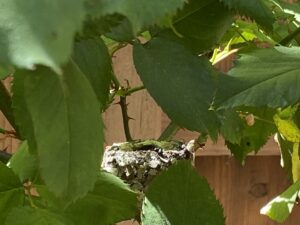 In this photo, the two little bundles of fur are barely
In this photo, the two little bundles of fur are barely
visible above the rim of the nest, with one little beak
pointing to the right.
So, now, we have work to do. Last time, after
asking for suggestions, we named Chelsie’s babies
Sam and Diane. We are confident that Chelsie
approved of our choices.
Now, we have to go to work on this important task once again. As before, we asked for suggestions.
Here is a list of the 26 suggestions we received:
Abbott and Costello Harry and Meghan
Barbie and Ken John and Paul
Batman and Robin Ralph and Alice
Bert and Ernie Regis and Kathy Lee
Butch and Sundance Ross and Monica
Captain and Tennille Sasha and Malia
Cheech and Chong Sonny and Cher
Daniela and Greg Steph and Draymond
Donnie and Marie Steph and Klay
Edith & Archie Varenna and Paris
George and Ringo Venus and Serena
Gloria and Meathead Woody and Winnie
Hall and Oates Yosemite and Ahwahnee
So, we did the obvious thing — we had an election. The families of our four sons got to vote. They each could select a first, second, and third choice and the votes were weighted accordingly. That vote yielded five finalists:
Donnie and Marie
Barbie and Ken
Bert and Ernie
Steph and Klay
Varenna and Paris
So, we had a runoff. Each person got one vote; and …
–> –> OK, it has been decided. We have a winner!
And here on the 22nd day of April, 2021, face-to-face with what passes for excitement these days in the world of COVID, we have named the babies. Chelsie will be happy to know that her babies have names. She can now call them:
—–> Barbie and Ken <—–
I am sure she will be pleased.
Voters who had other preferences may be interested to know that there was a tie for second place between:
Donnie and Marie
And
Steph and Klay
So, various points of view were represented in the voting.
… but we won’t tell Chelsie about the other nominees …
Meanwhile
The two furry little bundles are scrunching snugly in the nest. Chelsie chose a very secure and protected location for this one, so we don’t get much of a clear view. We have seen what looks like a beak protruding off to one side when Chelsie has flitted away briefly to find food. Otherwise, she dutifully sits on the babies in the nest and waits for them to grow.
Naturally, we have some questions, as we had last time. Will the warmer nights of late April be better for these two children than the cold nights of February that Sam and Diane had to endure in Chelsie’s last nest? Will they fly from the nest or fall from it — remember, last time Diane fell from the nest before she could fly and we had to lift her back into the nest. Will the neighbor’s prowling outdoor cat cause them trouble? I observe that the location Chelsie chose for this nest seems to be better protected than the last one. Will they need some help from us or … maybe … what we’ve learned is that the responsibility belongs to them and not to us. They seem to know what they are doing.
We’ll be watching.
![]()
Filed under: Family Stories | |Comments off
Our Baby Hummingbirds

Gretta: “I bet this needs to become a story … “
Click to download a PDF of this post:
ConVivio_The_Nest_Feb21-23
==============================================================
What Passes for Excitement These Days
About three weeks ago, Gretta began to notice that a small bird — a hummingbird — seemed to be hovering, flitting, fluttering around our front door when she walked outside to water the plants or emerged from our front door to go out for a walk around the block. Of course, as with most of our neighbors, over the past year, taking a walk around the block has been the most adventurous activity possible in our COVID world, so any variation from “the usual” attracted our attention. We decided to name this hummingbird Charlie.”
One day, we noticed that Charlie was sitting in a crook amid the sparse, recently-pruned branches of one of the rose trees about ten feet from our front door. On closer inspection, it looked like Charlie was perched on a small round knob of the tree a little more than the size of a golf ball. We wondered — Hmmmm — was it a nest? Later that day, when Charlie has not nearby, we went out for a walk, took a closer look, and found what looked like two tiny baby birds crunched into that “nest.” She showed me, “Look at this! It’s a nest. A nest with babies! We looked at each other and were stunned at the tininess of the nest and the babies. After a few steps, we stopped and one of us said, “She’s got babies. I guess we should name her Chelsie.”
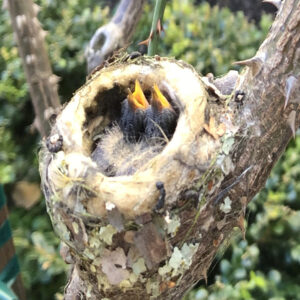
The next day, we happened to look out our kitchen window in time to see Chelsie land on the nest and begin to feed the two beaks protruding out of the nest. When she was done, she flew off, presumably to find more food, and I went out to take a picture. There they were, mouths wide open, apparently expecting more food. At that point, the story spread among the neighbors, each of whom took their turn dropping by to examine the wee neighbors. So, it began … the babies became the primary topic of conversation around the neighborhood. Such is the level of excitement required in our sheltered world of 2021.
So, over the next week, we noticed that Chelsie’s babies grew steadily larger, squeezed together more tightly each day in that little nest. We could see the emergence of what looked like two pairs of wings, with a slight greenish hue, on either side of each of the babies. Every few hours, we watched Mamma Chelsie land on the nest and vigorously feed the two open beaks with whatever food she was able to scrounge up at Costco or on her travels around the neighborhood.

About the start of the third week of this evolving spectacle, the babies, with what looked like wings tightly squished in the nest with them, began to change positions. Sometimes they both appeared to lay on their backs in what looked like their ‘feeding position. Other times we saw them in alternating positions, one on their backside the other more upright. Sometimes, they both assumed an upright position — giving the impression that they were contemplating the next step in their evolution: would they consider trying to spread those “wings” and try to fly? For us, that thought brought up two new ideas — one exciting and the other quite scary.
Walking in the park, we ran into our friends Ellen and Nancy, who both wanted to hear the latest report in the lives of Chelsie’s children. After telling them the latest developments and inviting them to drop by and take a look, Ellen asked a great question: “Have you named the kids yet?”
Hmmmmmm. “No, we haven’t. I guess that’s our next task, eh?” So, we resolved that we need to choose a couple of names. On the way home, some obvious pairs of names came to mind:
Ralph & Alice — Ellen’s suggestion Bert & Ernie
Sam & Diane Batman & Robin
Edith & Archie Butch & Sundance
Gloria & Meathead Stan & Laurel — Ellen’s suggestion
Mickie & Minnie David & Goliath
—> —> OK, we’ve decided. Their names are Sam & Diane.
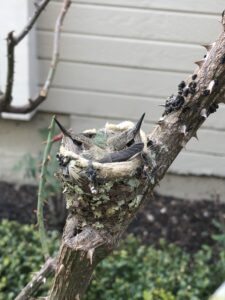
A second, scarier thought occurred to us as we noticed a neighbor’s grey-and-black cat prowling our street with its usual hungry look. That nest is a pretty tight fit for two growing birds, and it’s looking smaller every day as the babies grow larger. What if one of them spreads its wings and tries to fly before it is capable of “liftoff.” In that case, presumably, it would fall to the ground and, if that hungry cat was nearby, the baby would become lunch. It was a frightening thought. As caring and responsible .. uh … grandparents … or whatever kinds of relatives we were … what should we do? What could we do? What do people do?
And here on the 20th day of February, 2021, face-to-face with what passes for excitement these days in the world of COVID, that’s where we are. Do we have some kind of decision to make or is it our job to simply wait and watch and hope that Mother Nature and Mamma Chelsie actually know what they’re doing. Maybe the responsibility belongs to them and not to us. We’ll see.
—> —> The Story Continues — Sunday, February 21, 2021 <— <—
It’s Sunday morning and Sam & Diane are noticeably bigger. Their beaks protrude higher out of the nest; greenish things that look like wings fluff around their torsos; and they are moving around more inside the nest. At one point, Gretta got up on a step ladder to get a better look out our kitchen window and watched while Mama Chelsie dropped in and began feeding the babies. “Come and look! She’s feeding them!” I got a glimpse; but by the time I zoomed up my iPhone to get a picture, she darted away. She has a sixth sense for doing that. But, I did get a picture of the kids immediately after she fed them, looking all … well fed.
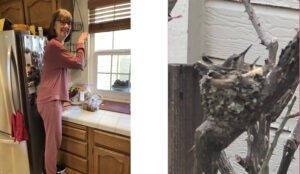
A few minute later, I got the best opportunity of all — Chelsie landed on the nest and fed them again. This time I had my iPhone at the ready and I got her in the picture. It’s a bit fuzzy, zoomed up that close through the window from my spot in the kitchen, but there she is.
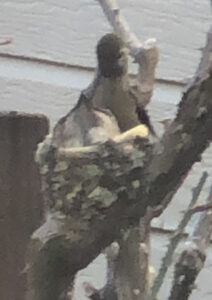
Then after she flew away, I took a chance, pushed the ‘video’ button, and a got a few moments of the kids squirming around a bit. Here they are in the closest thing I’ve gotten to “live action.”
(Video/audio file may take a minute or two to load) Click here: Squirming_babies
If you can play the video with sound, as Gretta narrates the scene, you might be able to hear in the background another voice in our household. It is the voice of our kitty, Peek-a-Boo, presumably complaining that another creature is getting more attention than she is at that moment, or — heaven forefend — lamenting that she would like to get out there, visit that nest, and do what … well … we just won’t go there.
As we watch Sam and Diane squirming around in their tiny nest, ruffling — nearly flapping — their growing wings, we speculate that it is just a matter of time, maybe just hours, before that nest becomes too small for them. This afternoon, in the photo below, we see them sitting on top of the nest, just like grown-up hummingbirds do. They looked strong and “ready.”
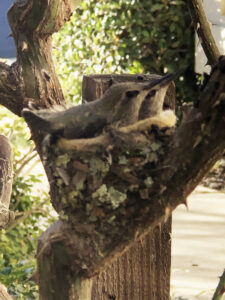
We wondered which one of those squirms and flaps will cause one of them to try to fly AND either:
One: fly away
or
Two: drop out of that nest to the ground and fall victim to … well, we won’t go there.
Honestly, they look like they’re ready to fly.
At that moment, some of the beauty and the danger came to life simultaneously. The reality of caring for these creatures carries with it the thoughts of the inevitable: these babies – like ALL babies — will one day leave the nest and venture out into the world with all of its opportunities and perils. When that day— when that moment — comes we will no longer be able to enjoy the sweetness that comes with the fact that they are here, being cute, posing for us each day in the nest, here at our home. So, we watch … and enjoy the moment.
Oh, by the way, lest we romanticize them too much … we must report that one of our baby birds, the one we’ve named Sam, now has a nickname. Gretta went out to take a closer look right after one of the recent feedings and Sam, without so much as a warning, let fly with a steam of … well … you know … a liquid stream that traveled at least two feet from the nest, just missing Gretta’s shoes. So, from today, Sam has the nickname “Pisser.”
We thought that was the end of the story for today … but, just before going to bed, at about 10:00
We went out to take another look and …
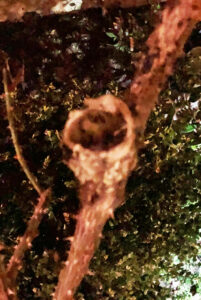
They were gone.
We experienced severe “Empty Nest Syndrome” the rest of the night. You can imagine.
Of course, we were not surprised. We knew, and you knew, that this moment would come eventually. In fact, from the way they looked the previous afternoon (in their latest photo, above) the one perched in front looked quite strong, looked fully formed, and for the first time appeared to be sitting on top of the nest, instead of scrunched down inside of it. So, we figured that they would fly away soon. Very soon. That turned out to be true.
—> —> The Story Continues — Monday, February 22, 2021 <— <—
“And it was evening and morning, the next day”
I got up and came downstairs about 7:30 am and walked out the front door to take another look. Once again, the nest was still empty. (Well, whadya’xpect?” you may ask.) I looked around a bit and found something on the ground. After staring for a long moment, I realized that I was looking at a small bird standing there about three feet from the base of the “home” rose tree that contained the nest. It was apparently the smaller of the two babies we had gotten to know in the nest. We had read that if a baby bird falls from a nest, you can pick it up by the torso and place it back in the nest. So, I did that. When I first touched it, the bird flapped its wings and scampered about six inches along the ground — I took that to be its incomplete attempt to fly. I then picked it up and placed it in the nest.
Wow!
I took a picture and went back inside to report that one of the babies was back in the nest, for now.
Monday morning. The little guy — below — temporarily back in the nest after getting a “lift.”
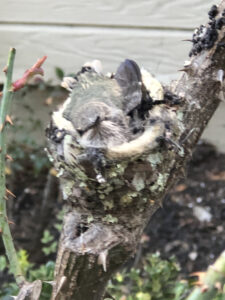
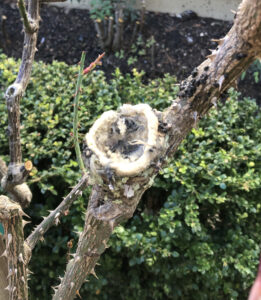
Well, by 10:00 am, the nest was empty again.
Looks like Mama Chelsie and her two babies
Sam & Diane (now growing, lively kids) were flying and on their own.
= = = = = = = = = = = =
And now for the good news. For the rest of this day, Monday February 22, we have seen Mama Chelsie and her two kids flitting about among the rest of our rose trees and the large tree out in the front lawn. And, just like the hopes and dreams we have for all of the babies we know as they grow up — they can fly on their own.
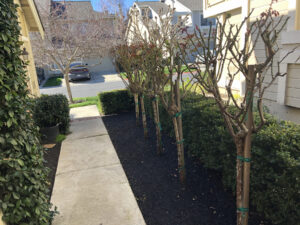
—> —> And Well, that’s the story of Mama Chelsie,
and her two kids, Sam and Diane.
so far … <— <—
= = = = = = = = = = = = = = = = = = = = = = = = = = =
OK. just one more thing — proof of success. This is a picture of Diane, the smaller of the two babies, perched near the top of a tree in our front yard. She’s on her own.

Left: Diane viewed from the ground (up near the roof). Right: Diane up close.
![]()
Filed under: Family Stories | |8 Comments
Sister Bernadette and The Bully
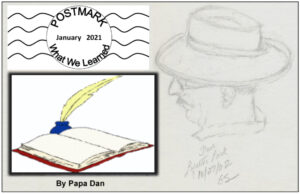
Sister Bernadette did her job back in the day.
Now, we must do ours, as she taught us.
Click here for a PDF of this post: Sister_Bernadetta_and_the_Bully
= = = = = = = = = = = = = = = = = = = = = = = = = = = = = = = = = = = = = = = = =
What We Learned: — ‘The Way It’s S’posed To Be’
I grew up in Antioch, California, where my parents sent me to an excellent elementary school starting with the first grade in 1956 through the eighth grade in 1964. There, I was well prepared to become a good student, a basketball player, and a leader in high school. I was encouraged to become especially serious about reading and writing. Most of my teachers at Holy Rosary School were Dominican Sisters — I have enduring memories of Sister Marilyn, Sister Bernice, Sister Dymphthna, Sister Emily, and Sister Bernadette. At the 50-year reunion of our graduating class, our eighth-grade teacher Sister Bernadette (she was also the school principal) was there to congratulate us. I am proud that, on that day in 2014 (she was 89 by that time), I told her “I am nearing the end of a long successful career as an Editor and Writer and YOU taught me how to write fifty years ago.” She seemed pleased.

<— Left: Sister Bernadette
— Holy Rosary School Principal
— My 8th grade teacher (1963-64)
— Assistant God
<— Right: Sister Emily
— My 7th grade teacher (1962-63)
— Dodger fan (we loved her anyway)
I have always been grateful for that academic preparation, but also for something else. I was also taught to expect that some things constituted “the way it’s s’posed to be.” We were taught to tell the truth and follow the rules, to be fair and honest in dealing with other people, to be serious about our schoolwork and athletics, and to respect our classmates and our elders (even those who were Dodger fans). Most important — she taught us these things by her example. We saw her live up to the values she taught us. After these many years, three moments stand out in my memory as examples of “the way it’s s’posed to be,” as taught to me by Sister Bernadette. These moments speak to me as illustrations of the power of her example to make sure “the right thing” happened. The third of these three examples make me wish that Sister Bernadette was here in America today to wield the kind of authority she had on the playground at Holy Rosary School six decades ago.
One memory is an example of the power she had that enabled her to have an effect on my life. One afternoon, I was walking out of school, happily carrying the leather briefcase my father gave me to carry the books I enjoyed (Mark Twain and others). Gene Banti, who unbeknownst to me was the 7th and 8th grade basketball coach, passed me on his way into the building. Without any introductions, he stopped dead in his tracks said, “You’re tall!” I felt like he had accused me of something. “What grade are YOU in?”
I didn’t like his tone of voice.
“I’m in the 7th grade.”
“You need to be on the basketball team. Practice is Wednesday after school and I want you out there.” This was turning out to be a very uncomfortable moment in the bright afternoon sun. I didn’t like where this conversation was going.
“No … I’m sorry … I can’t.” I made up some excuse about Wednesday, which apparently was unsatisfactory.
“Oh, no. I’ll speak to Sister Bernadette about it. You’ll be out there on Wednesday.” That’s how Junior High basketball coaches talked in the early sixties. Sure enough, through the awesome power and influence of Sister Bernadette (she called my mother), I found myself on the basketball court on Wednesday afternoon. The fact that I had no basketball skills didn’t matter. It turns out that Sister Bernadette wasn’t though with me yet.
After a month or so of that first basketball season, Sister Bernadette walked up to me on the playground during recess carrying a basketball. She said, “The coach tells me you can get rebounds and score, but when you try to dribble you’re an embarrassment to you and to me.” She instructed me to spend every recess dribbling the basketball up and down the convent driveway “until the coach says you can dribble.” I had been given an assignment, and I learned that part of my responsibility on the basketball court was to make other people proud of me.
After all that I learned that season, basketball got me started on a long career as a “regular kid” who developed enough skill on the court to play varsity basketball in high school and, later, to become a basketball coach myself. Once again, Sister Bernadette displayed the awesome power and influence she had to make things turn out ‘the way ‘it’s s’posed to be.’
So, my third example is the one that I want to apply to the world as we know it here, in America today. This one goes back to the Spring of 1960. The scene takes place on the Holy Rosary School playground. I am in the fourth grade, standing in line, waiting my turn at the tetherball court, when our well-known playground bully — he was a fifth-grader — cut to the head of the line. When someone yelled something like “Hey, the line starts back here. You need to wait your turn.” He replied through his powerful smirk, “And who is going to make me?” Everybody in line knew better than to reply to that question; so the bully kept his place at the head of the line.
BUT … then it happened.
Sister Bernadette regularly spent the recess time patrolling the playground. She happened to be strolling right behind the tetherball line when the bully pulled his stunt. Right after his “who is going to make me?” question, Sister Bernadette grabbed the bully by the ear (as my 4th-grade memory recalls) and hauled him off across the playground to her office — the Principal’s Office. His question had been answered. (Now, I grant you, it is possible that, in reality, she gently held his shirtsleeve and guided him across the playground to her office, but … my 4th-grade sense of justice stands by the original description.) What we learned is that she called his parents, they had to come and take him home, and we didn’t see him for the rest of the day. So, that is the example of clear authority and swift justice that Sister Bernadette represented. Doing the right thing was required and enforced. The rules had to be followed. That is the lesson we were taught in the classroom and on that playground; and, when necessary, that lesson was demonstrated.
So, here we are today, sixty years later, in an America that claims to be a nation of laws. A nation that claims to lead the world in support of recognized values for the common good. A nation, we were taught in Sister Bernadette’s classroom, where a constitution governed the rules and the rules were enforced by legitimate authority for the common good — just like they were enforced on our playground at Holy Rosary School. And here in America, over the past four years, we have found ourselves burdened under the painful weight of a bully — a presidential bully — who regularly violates what we have been taught about telling the truth and following the rules, about being fair and honest in dealing with other people, about being serious about our assigned responsibilities, and respecting other people (even those who were Dodger fans). Our constitution and our institutions are tasked with the responsibility to grasp the bully by the ear and drag him off the playground, when necessary. Today, America needs that same kind of enforcement of our common values. Our institutional “Sister Bernadette” — our Constitution, as reinforced by the will of our people as expressed by their votes — must step forward and do its job. We have responsibilities to make that happen. Sister Bernadette did her job back in the day. Now, we must do ours, as she taught us.
= = = = = = = = = = = =
Sister Bernadette passed away peacefully on November 5, 2019 at the age of 94.
Her obituary revealed more things to admire about her life that I didn’t know.
(https://www.legacy.com/obituaries/SFGate/obituary.aspx?page=lifestory&pid=194456421 )
========================================================
But — Since Then, We’ve Learned Some Other Things:
‘The Way It Is’ and ‘Who We Are’
In Sister Bernadette’s classroom, we learned a lot of things. We learned about the founding of our nation and its history. We learned that America was founded on some important words:
“We hold these truths to be self-evident, that all men are created equal,
that they are endowed by their Creator with certain unalienable Rights,
that among these are Life, Liberty and the pursuit of Happiness.”
The words were written by Thomas Jefferson; and the 56 men who signed the document are widely considered to be among our founders. What we learned later: 41 of those who signed our founding Declaration owned slaves, including Jefferson. Among those who were not slave owners, John Adams unsuccessfully insisted that the Declaration condemn slavery and announce the end of slavery in America. He lost that battle. It was reported that, on July 2nd, 1776, he warned, “If we give in on this issue, there will be trouble one hundred years hence.” The “trouble” that happened a century (85 years) later was the Confederacy and the Civil War in which eleven states seceded from the union and went to war against the United States to preserve their “States Rights” to own slaves. Americans killed each other in this “trouble.”
We also were taught that the Union defeated the Confederacy and ended slavery in America. What we did not learn in that classroom: 620,000 Americans died in that war; about half of them were soldiers. In that classroom, we did not learn about the Jim Crow laws that made it impossible for former slaves to exercise their “inalienable rights” as free Americans, nor did we learn about the pervasive segregation that kept African Americans separate and not equal to their white fellow citizens well into the days we sat in Sister Bernadette’s classroom. That truth contributed to the fact that no African Americans lived in our town at that time.
So, it turns out that, “We The People” of the United States of America include a significant number of people who do not support the inalienable rights of people of different races. That same ”We” includes people who do not believe in free and fair elections and it includes the 73 million Americans who voted for the current Presidential Bully. So, one of the great challenges facing America going forward is to face the tragic reality of who “We” are and decide what to do about it. The answers to that challenge were not taught to me in Sister Bernadette’s classroom.
![]()
Filed under: Family Stories,Politics,Who We Are | |2 Comments
A Day to Remember Mario Russo
Mario Russo grew up in Pittsburg, California, one of nine children, in a family of immigrants from Isola Della Femmine, near Palermo on the Island of Sicily in Southern Italy.

Here, as a teenager, with his mother in their grocery store in Pittsburg.

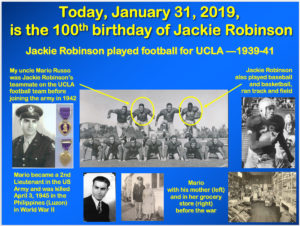
A football scholarship brought him to UCLA where he was a teammate of Jackie Robinson, who would make history as the first African American player in Major League Baseball.
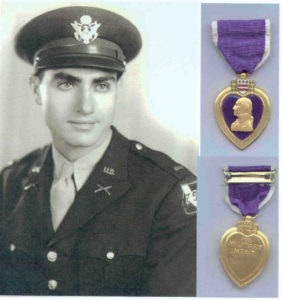
After a promotion to Second Lieutenant in the Army, World War II brought him to the Island of Luzon in the Philippines, landing there on January 9, 1945. They where in constant combat until he lost his life on April 3, 1945, fighting against the Japanese.
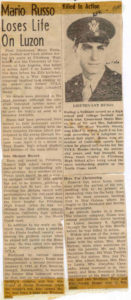

Here is more of the story:

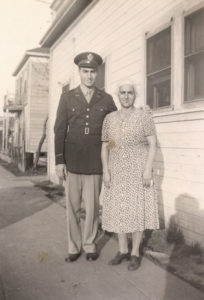
![]()
Filed under: Family Stories,Who We Are | |Comments off
An Optimist Travels North
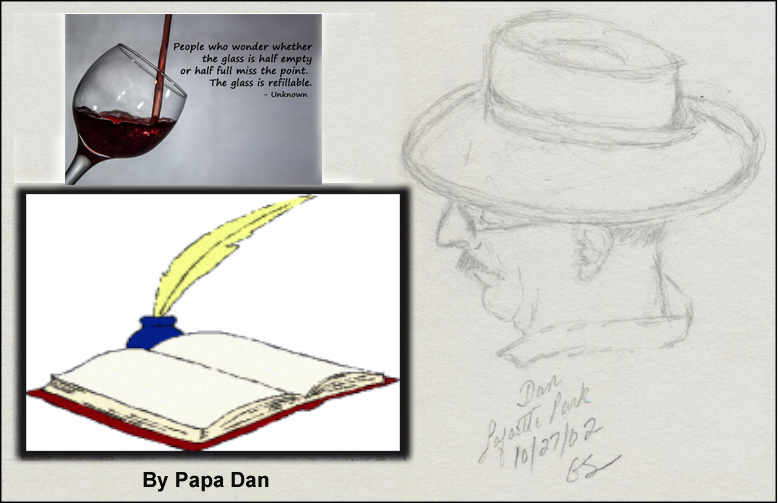
“A pessimist sees a glass that’s half empty.
An optimist sees a glass that’s half full.
They both miss the point.
The glass is refillable.”
— PapaDan (and many others)
=============================================================
A New Year Brings Some “New” Ideas
The New Year often brings with it some “New Ideas” — some are trivial, some are significant, and some of those ideas are actually new (but not all of them). Lyrics to an old Allen and Sager song come to mind —Everything Old Is New Again — reminding us to be open to “new” ideas and also to the possibility that some of those ideas are not so new.
Of all the “Not New” ideas that have risen to the surface with the coming of the New Year, one that has dominated a good deal of our national conversations has been immigration. Since I come from a family of immigrants, that subject has captured my imagination. As I’ve written before, my immigrant grandparents and their children — who became my parents — were impressive optimists. Looking back on the struggles they endured before taking the leap to come to America, their optimism is quite a surprise. The stunning poverty that “booted” my grandparents out of Southern Italy and the earthquake that destroyed everything they knew there, could very well have had the opposite effect on their belief in a future; but they got on boats, spent weeks in steerage just to settle in a dusty coal-mining town in West Virginia, before launching another journey across a continent to California – but that’s a story for another time.
As I look back, what is left to me — to us — are their stories. That’s really all. In my case, stories from dawn of the twentieth century. So, as I hear fragments of stories from here and now, the early years of the twenty-first century, my imagination has been trying to recreate today’s stories of those who are so much like my grandparents. What are their stories?
Here Is Just One
Midway between Mexico’s border with Honduras and Mexico’s northern border, a man named Ronaldo came home late in the evening to the shelter his family had occupied for the past week, as they traveled north. He had been able to acquire some ears of corn, a bag of beans, some bread, and some bananas. Some days he did better than others, but today wasn’t so bad for the last week of December. His six-year-old son liked the bananas, his wife, Alma, appreciated the beans and the corn but, here in this shelter, they didn’t have a way to cook them; so, they would have to wait for a better location on their way north. Ronaldo told his wife in their Honduran dialect, “There are stories in town about ‘asylum’ in the north,” he said. “Asilo” was a word whispered in town among Hondurans who had gotten this far and had dreams of travelling farther north; but there were both good stories and bad stories. Ronaldo’s Uncle Mario had spoken of “asilo” in America and left Honduras five years ago hoping to make it to the American border and apply for asylum. He had learned the rules and figured that their attempt to escape the official corruption, street gangs, and poverty of their hometown would get his family into America.
Uncle Mario and his family left in the summer — and no one in town ever heard from him again. Ronaldo imagined two possible outcomes: one, that he had succeeded, entered Texas, made his way to California, and found a job as a fisherman in San Diego. Eventually, Ronaldo imagined, Mario may have even travelled farther north to the Central Valley and worked on one of the prosperous farms they had heard about. Uncle Mario had experience in the vineyards and fruit orchards in Honduras and Ronaldo figured he would do well.
Ronaldo had heard stories like that in the bodega where he had worked in Honduras.
Ronaldo also imagined another outcome, that his uncle had been harassed at the border, rejected, and faced the harsh combination of the American immigration system and crowds of desperate people. Those were terrible stories; but Ronaldo put them out of his mind — expecting better from the Americans. After all, America had a reputation as a nation of immigrants and a welcoming history, or so he had heard. As Ronaldo unloaded his cart he told his wife, “The time is right. It will be a New Year — 2019. Let’s leave in the morning.” So, they agreed to pack the cart with the food they had stored and bags of clothes, and left before dawn.
It took 15 days to reach the US border. It was not an easy passage — some food was available, but it was not cheap. Along the way they ended up in a large stream of people like themselves, most without vehicles, with the same plan. Out of caution, they looked for places to sleep away from the crowds, not sure what to expect from the others. They arrived at the border on Thursday January 10 and there was a bit of a commotion. People told stories that the American President was taking a tour of the border and there were some disturbances; but Ronaldo didn’t believe that — why would the President do that? That would seem to just cause trouble.
While waiting his turn to approach the checkpoint and apply for asylum, Ronaldo was optimistic. This was a new idea for his family, even though many others had this idea before him; and he was proud that he had gotten his family this far. And so they waited.
In reality, this was clearly not a “new” idea. Seeking a promised land was an ancient idea, but it felt new for Ronaldo’s family and the thousands of others waiting at the border with the same idea — waiting for America to fulfill its historic promise. And so they waited.
As they waited their turn for his dream to come true, Ronaldo remembered the bible stories he was taught in his youth — Moses and Joshua arriving with a large crowd of migrants at the threshold of The Promised Land. The story he was told as a child was offered as a triumphant example for those who are willing to be patient. But, as he grew up, read the rest of that story, he recalled that the Israelites were found to be unworthy when they arrived at the border and wandered forty years in the desert. After a whole generation of that caravan died in the desert, Moses handed the leadership of the Israelites over to Joshua. Moses died within sight of the Promised Land on Mount Nebo while Joshua went on to complete the task of leading the Israelites into the Promised Land. And that’s when the battle and the real struggle actually began.
As Ronaldo waited and heard more stories of migrants approaching the American border, he wondered: would the coming days be triumphant for him and his family, like Joshua’s entry into the Promised Land?
Or would his experience be like Moses — a dream, a promise, and a long hard journey with an abrupt ending? Would others tell HIS story?
And if his story did turn out like Joshua and his people, how would his children tell the story AFTER the crossing? Would they be welcome in The Promised Land or would a new battle begin?
Ronaldo was insistent — he would be optimistic. And so he waited.

Filed under: Family Stories,Fiction,Ideas | |2 Comments
A Path From Fear To Hope

= = = = = = = = = = =
= = = = = = = = = = =
“Look to those who have gone before us.
They have much to teach.”
Click here to download a PDF of this story:
1-ConVivio_from_fear_to_hope
= = = = = = = = = = =
= = = = = = = = = = =
= = = = = = = = = = =
= = = = = = = = = = = = = = = = = = = = = = = = = =
 We’ve been taught to hope by people with a lot of experience.
We’ve been taught to hope by people with a lot of experience.
For me, it started with my grandparents. They escaped fear, poverty,
and a devastating earthquake to sail across an ocean to America
111 years ago. With no marketable skills, my grandparents Antonio and Giovanna Maria survived a West Virginia coal mine, a typical destination for illiterate Italian immigrants, and crossed a continent to California
to grow grapes and make wine. (During prohibition, so the story goes, people came from miles around to buy his ‘expensive’ oranges and he gave the wine away for free.)
<– Pictured: Antonio front/center, Giovanna Maria right.

The grandchildren of those pioneering immigrants grew up during the depression (my sister) and then in the stability and prosperity of the 1950s (myself). Both learned that hope was justified. Then, Antonio’s great-grandchildren became well-educated contributors to a complex California society and their children, growing up here in the 21st century, four generations after Antonio and Maria’s immigration, are being raised with an strong belief in a hopeful future.
It is not an unusual story. Lots of people have similar family stories of progress across generations. America has been on a hopeful path — an upward path — for a long time.
But that path has not been a straight line.
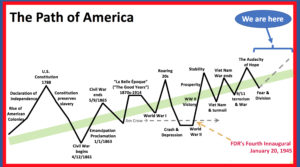
The Path
So, we have arrived ‘here’ (shown in the upper right corner of the timeline pictured above). The quote at the bottom, from Franklin Roosevelt’s fourth inaugural address at the height of World War II, describes America’s path. Great heights of achievement have been followed by declines into great depths of fear; followed by sharp advances in the fortunes of America and Americans:
• The rise of the British colonies to independence and the rule of law led to the U.S. Constitution
• The compromise of the constitution established slavery as a fixture of American life
• The argument between strong national government and the pre-eminence of individual states — driving bitter divisions on the morality of slavery — led directly to the Civil War.
• Elation in the Union’s victory and the end of slavery was countered by the despair of the South that their culture had been destroyed. As a result, the former Confederacy effectively sabotaged that northern victory by refusing to allow any semblance of equality for African Americans. That led to the establishment of “Jim Crow” laws and practices that perpetuated longstanding racial divisions that remain with us today and overshadowed the period of recovery after the war.
• Forces that drew America into World War I led to an even broader international downturn.
• The end of that war led to a period of prosperity, and then a deep world-wide depression.
• Then, of course, World War II — plunged the world into another monumental disaster followed by another cycle of victory, prosperity, and stability (for many, but not all).
• Then of course, Vietnam and the political, cultural, and racial turmoil of the 60s and 70s — the end of that war was celebrated as an upturn, followed by the rise of terrorism.
• The Obama presidency led many to believe that America had moved past racism and division, only to find that reactionary forces would bring American back to a period of deep divisions in all segments of society and fear of the future.
Phew!!! What a ride!
After all those ups and downs, here we are, well into the 21st century. Despite evidence of prosperity and technological advancement, once again, there is fear in the air. Just as it was with other “lows” in American history, that fear is not concentrated in any one segment of society. Many who are prosperous fear that their prosperity may be lost to forces beyond their control. Many fear that their pre-eminent place in society may be undermined by people who are different from them. Those striving to improve their prosperity and rise to a better place in American society fear that those wealthier and more powerful will push them down and sabotage their struggle to advance. American values that we were taught would provide opportunity for success with hard work and education seem to be increasingly out of reach for those most in need of that opportunity.
That condition is not new. American history, as documented in recent months by some of our most respected historians, has often been punctuated by moments of despair — times when the demise of the American experiment seemed likely and imminent. Doris Kearns Goodwin writes in her new book, “Leadership in Tumultuous Times,” that it took extraordinary leadership by people like Abraham Lincoln, Franklin Roosevelt, and others to bring the nation back from serious disasters and back to an upward path. Jon Meachem makes a similar point in his new book “The Soul of America — The Battle for Our Better Angels.” One key message both of them convey is that, at times of maximum fear (the downward spikes on the timeline), strong leadership and widespread belief in positive human values have reversed that decline and pushed America back upward toward hope. Meacham’s overarching point is that the ‘up-and-down’ feature of the path of American life has always been a constant struggle between hope and fear. We all grew up learning Franklin Roosevelt’s famous advice in his 4th inaugural address: “We have nothing to fear but fear itself.” That was important for the people of his time to hear during the darkest time of the war. But he had something more important to say to us, who would come later. He said:
“Things in life will not always run smoothly. Sometimes we will be rising toward the heights
— then all will seem to reverse itself and start downward.
The great fact to remember is that the trend of civilization itself
is forever upward; that a line drawn through the middle
of the peaks and the valleys of the centuries
always has an upward trend.”
We see that in my timeline, pictured above. So, when we look at the fear many of us have today, our history reminds us that, when we reach a low point, a rise is imminent. That is the basis of hope — the hope that drove others before us, like our grandparents — and that must drive us forward today. Meacham, writing this year, provides an important comparison to the inspiration that came from Roosevelt in 1945:
“In the best of moments, witness, protest, and resistance can intersect with the leadership of an American president to lift us to higher ground.”
And then his message for us, today:
“In darker times, if a particular president fails to advance the national story,
— or worse, moves us backward — then those who witness, protest, and resist
must stand fast, in hope, working toward a better day.”
Progress has been “slow, painful and tragic,” he tells us; “Yet the journey has gone on, and proceeds even now.” As a historian, Meacham tells us, “There’s a natural tendency in American political life to think that things were always better in the past … that ‘once there was a Camelot,’ without quite remembering that the Arthurian legend itself was about a court riven by ambition and infidelity. … Imperfection is the rule, not the exception.”
The message delivered through Mecham’s chapters is that progress has always been a struggle between fear and hope. So, you may want to cut to the end and ask “Which wins — fear or hope?” The answer is “both fear and hope have their moments of victory, but both are temporary.” It is our job to figure out what we must do to shorten the victory of fear and hasten, maybe even lengthen, the victory of hope.
The cynics of our time have tried to discourage us — “Hope is not a strategy,” they’ve told us. The truth is: hope must be the foundation of a strategy of action. We’ve asked these questions before and now we must answer them:
“What must I do?”
“What must you?”
Look to those who have gone before us. They have much to teach.
![]()
P.S. Take a look at “This Week in Good News”:
https://www.nytimes.com/2018/11/22/briefing/week-in-good-news-chess-norway-steven-pinker.html?smprod=nytcore-ipad&smid=nytcore-ipad-share
Filed under: Family Stories,Ideas,Who We Are | |Comments off
Welcome to ‘liam

June 9, 2018 — Today we say hello
to the newest member of the family.
His name is William Daniel Sapone:
Son, Grandson, Brother, Nephew, Cousin.
By the way, he is stunningly handsome,
but you knew that, eh?
At 9.7 pounds, 22 inches, he is already
writing his own story, with the loving and wise guidance of his proud parents,
William and Maria.
= = = = = = = = = = = = = = = = = = = = = = = = = = = = = = = = = = = = = = = = = = =

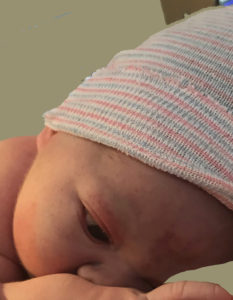

William Daniel Sapone: Born at 2:01 PM, Saturday, June 9, 2018
— 9.7 pounds, 22 inches long. He will be called Liam.
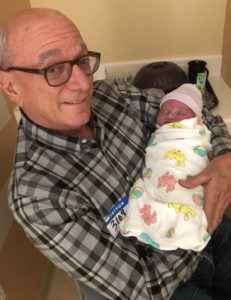
My first observation, right after noticing that he is really good looking (did I mentioned that?), was that he seems remarkably calm and composed. His eyes are open in his first picture (above, center), seeming to focus on his fingers (“Wonder what these are for?”), until his attention is diverted by his PapaDan’s gentle humming of his favorite Beatles’ song “Here Comes The Son.” He quickly closed his eyes and returned to his “calm and composed” posture. I figured he was soothed by the sheer musicality of my rendering of the tune. Others in the room suggest that I may have bored him back to sleep, a credible suggestion that I quickly rejected. (OK, so I made this up.)
ANYWAY, needless to say, I was thrilled at having the privilege of sharing this first afternoon of William Junior’s life (in the hospital) with Papa Manny (Maria’s father), and Liam’s spectacular parents Maria and William. They were both smiling. Manny and I got to bring some dinner (she wanted a steak) to the proud parents while Diane and Gretta were hanging out with Madison at home. Below are a handful of pictures from William, Junior’s first couple of days in his well-appointed suite in Kaiser hospital in San Leandro and then home.
Welcome to our family, Liam!
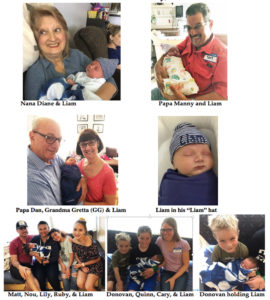
And the most important pictures of all — Madison meets Liam:
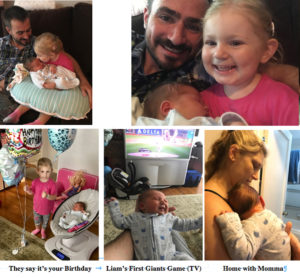

How’d We Get Here?
Two Saturday’s ago, we tried a well-known trick to entice the baby to make his Grand Entrance — we took Will, Maria, and Madison to Skipolini’s Pizza in Walnut Creek. It has a long history.
Here’s the story: In the spring of 1981, a woman burst into Skipolini’s Pizza, near the end of a long pregnancy (is there any other kind?). She demanded that they give her a pizza that would make the baby arrive soon. Seeing her desperation, the manager concocted a pizza with thirteen toppings, extra onion and extra garlic, and six types of meat. The woman left Skipolini’s after eating the “Prego” pizza and went into labor that same evening. So began the story of the original “Prego” pizza. After years of success, the “Prego” pizza has grown in popularity, recommended by doctors and OBGYNs, recognized on local radio, TV, magazines, and newspapers. SO, here we are, waiting for our “Prego” and hoping to get this show on the road.

Of course, it worked, sort of, mostly, that is, eventually. Maria went into labor two weeks later and William Daniel Sapone was born at 2:01 pm on Saturday June 9. Learn about the legacy of Skipolini’s —> http://www.skipolinispizza.com/prego.php
On the big day, I got an urgent call at 7:30 that it was time to come and stay with Madi while her parents went to the hospital. I arrived at 8:00 and Will and Maria swooshed off to the hospital while PapaDan and Madi played with Play-Doh and watched “Paw Patrol.” Meanwhile, Manny and Diane (Maria’s parents) arrived and joined in the serious work in Play-Doh and crayons with Madi, until it was time to take Madi to Vic’s for breakfast. While getting ready to go to Vic’s, the assembled grandparents demonstrated their calm experience under pressure. PapaDan locked the front door while Manny put Madison in her car seat in his truck parked in front of the nearly identical house next door. Diane had a bag of things in the truck to put in the house. So, Dan & Diane purposefully walked up the steps of the porch to the front door. Dan lifted the key to the lock, noticed that the doorknob and deadbolt seemed different from the door he had just locked, but ignored the observation. For a moment, it felt like the right house because there was a dog barking inside, just as Winston had been barking inside of Will and Maria’s house that I had just locked. Manny saved us by shouting, “You’re at the wrong house,” so we walked back toward the right house as the neighbors opened the door. They were most gracious when Diane explained that “our daughter was about to have a baby.” They seemed to understand our condition. We went next door, unlocked the more familiar front door of the right house, placed the bag inside, relocked it, and … we were off to Vic’s.
OK, I guess you had to be there …
And the sun sets on June 9, 2018 — the first day in the world for William Daniel Sapone
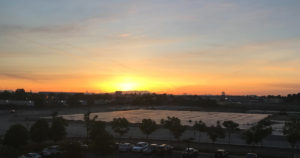
And so it begins … ![]()
Filed under: Family Stories,People who Make Us Smile | |2 Comments
A Ride to Nana’s House
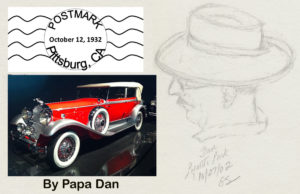
Dedicated to my timeless sister.
View a PDF of this post:
76-ConVivio_1931_Packard
Danville, California — A rainy Sunday afternoon was made to order for a trip to a museum; and just a few miles up the road in Danville, we’ve got the famous Behring Auto Museum. Since we had never seen it, Gretta and I decided to spend the day strolling through one of the finest collections of classic sports cars on the West Coast.
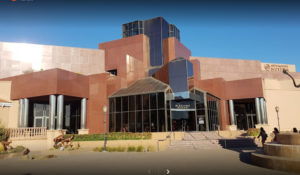
The modern building has polished stone floors, elegant lighting, and two stories of magnificent cars — some of them one-of-a-kind, many specially built for royals or movie stars. After just a few minutes surrounded by the likes of a 1933 Alpha Romeo, the only existing 1911 Silver Ghost Rolls-Royce, and Howard Hughes’ black 1929 Duesenberg, I felt transported to another time.
Trying to visualize a street where cars like these were actually driven took some serious imagining. But when I literally (ooops!) bumped into the magnificent 1931 red-orange convertible Packard 840 Deluxe Eight, my imagination was fully engaged. I pictured myself face to face with Jay Gatsby in his circular West Egg driveway, one foot on the running board, adjusting the mirror strapped to the spare tire, polishing it with the handkerchief from the breast pocket of his white linen suit. The uniformed security guard didn’t much like the fact that I had accidentally touched the classic, “Please be careful, sir. We much prefer that you not touch … ”

Yes, I’m sorry, it sorta snuck up on me.”
I grinned but he was not amused. So I offered
what I thought wound be an additional apology:
“This one is just stunning, don’t you think?”
“Yes, sir. The Packard does bring a person
back to a more … interesting … time.” His
expression suggested that he had some
experience with that time — and he seemed
to prefer it to now.
“I bet you know these cars better than anyone, Mister … uh …?”
“Yes, sir. Carraway, sir.”
“Do you ever get to drive these cars, Mister Carraway? I mean, after hours maybe, when no one’s around?”
“I WOULDN’T THINK OF IT, SIR!!” He raised his voice a bit and looked me in the eye for the first time, as if I had accused him of something serious. I grinned back at him as if to share a guilty secret. He looked away thoughtfully, back to the Packard. “Owners take some of them out from time to time, keeps them alive, so to speak. But this one … ”
“This one is different?”
“Yes, sir. Different. Special. Has a life of its own and a tragic story. Timeless, you could say. Really should be driven regularly; it’s pretty smooth for an eighty-five-year-old.” The first hint of a smile appeared and was quickly withdrawn.
“Now you’ve got me intrigued, Mister … uh … Carraway, you said. Sounds like you’ve gotten to know this one.” No reaction. “I read in your brochure that they made only a few of these. The sticker price was pretty steep — $3,200 was some real money in 1931, eh? I wonder how many people could consider buying one of these in the depth of the Depression?”
“Only one that I knew at the time.”
“At the time … ?”
The straight-faced guard looks at his watch, “Sir, you know it’s getting to be time to close. You’ll forgive me if I begin.”
“Of course, I’ve taken too much of your time already.”
“Not at all,” he said, turning to leave.
Alright, I couldn’t resist — “Mister Carraway, one more thing, if I may. If a respectful gentleman were to … uh … linger here at closing time one day, if he were willing to wait a while, quietly … I wonder if it would be possible — not to drive it, of course, but when you … perhaps … uh …”
“Forgive me, sir, I really must close.”
“Of course, perhaps we’ll talk another time.”
He nodded but said only, “Good afternoon, sir.” It was clear that I had been dismissed.
Over the next week I just couldn’t get that ’31 Packard out of my mind. I imagined Mister Carraway locking the museum doors at closing time, setting the alarms on the public entrances, and slipping back to the shop area to retrieve the keys to the Packard. In my melodramatic imagination, he would turn off the closed-circuit surveillance cameras, push the red-orange beauty through the back door into the shop, start it up, and drive it out into the back lot. I wondered if he had the nerve to take it out into the public parking lot or even — NO WAY — out into the nearby residential neighborhood. Of course, the fact that this magnificent vehicle would be completely out of place in this neighborhood and … well … in this time, made it a ridiculous idea. It isn’t something he could pull off unnoticed.
As the days passed, I became increasingly convinced that Mister Carraway did exactly that — and I indulged my outrageous fantasy that I could somehow join him on one of his rides. But how? Maybe if I did some research and showed up spouting a wealth of knowledge about the ‘31 Packard and not a little admiration, maybe he would be impressed by my love of the machine and its history and give me a ride. It wasn’t a great idea, but it was the best I had; so, I turned to the Internet.
The results of my search were quite interesting. It seems that Packard made a strategic decision to try to beat the effects of the market crash of ’29 by building a vehicle even more luxurious and more expensive than ever before. They figured that those who still had that kind of money would want the most opulent model they could find and would abandon the mass-produced “luxury” cars like Cadillac, which they judged, would soon be going out of business. It sounded like a half-baked strategy to me; and it turns out that they badly misjudged the very small number who would survive the crash with that kind of money and ended up building and selling precious few of them.
So, ten days later, after doing my homework, I showed up on a weekday afternoon when I hoped there would be fewer visitors. I found Mr. Carraway leaning against one of the “Please do not touch” signs, looking bored. At the risk of being a pest, I greeted him: “Ah, Mister Carraway, nice to see you again. Last week I fell I love with your ’31 Packard over there and I’ve done some reading. It has a bit of a history.”
“Yes, sir, I remember your interest. It does have quite a history.” He followed me as I walked over to the red-and-orange beauty.
“I learned that the few who owned one of these included some big names — some Hollywood folks, some politicians, ‘captains of industry.’ I’d love to know who owned this one.” I touched the hood gently with what I thought was proper respect.
“Sir, PLEASE.” With a deep frown, Mr. Carraway took out a handkerchief and wiped my fingerprints off the hood and made a visible effort to quell his annoyance that I had been so presumptuous to have touched the Packard on purpose.
“I’m terribly sorry … I’ve done it again. Please forgive my carelessness. I know it’s no excuse but I do feel such a connection to this vehicle. Makes me feel that somehow, we can connect to the world it comes from — something I’d love to do.” With a thoughtful nod, he seemed to approve of my feeling of connection. So, I plunged into my strategy: “I read some stories on the Internet — and I remembered that you mentioned a “tragic story.” I read about Jean Harlow and how she had a Packard like this one. I was hoping to learn more. I keep thinking about all the stories these cars could tell about the people who came before us. What do YOU think?”
He hesitated, then looked me in the eye; it was 4:30 and the place was almost empty. Before he could tell me it was time to leave, I continued, “I was hoping we could talk more about the tragic story you mentioned last week.” To my surprise, he suggested that I wait here while he closed up shop. “I’ll be a few minutes,” he said.
When he returned after securing the public entrances, he told me that none other than movie executive Paul Bern had bought this Packard for actress Jean Harlow on her 21st birthday in 1932 to celebrate the movie contract with MGM he had negotiated. They were married that year but two months later he committed suicide. And when she died suddenly only five years later, the car became he property of the MGM studio.”
“Oh, my. I read that story — I was captivated. So, THIS is the one! What a privilege to see it!”
“The very one, sir. The heirs donated it to the museum when it opened in 1988.” He hesitated, seeming to make a decision about what to say next. Finally, “It has some ‘remarkable features.’”
“So, it still runs. Wow! Remarkable features, you say? Let’s see, I read that its larger valves, a special fuel pump, and a preheated fuel mixture increased its power and it was one of the first cars to exceed a top speed of 100 miles per hour. Pretty remarkable for the 1930s.”
“Well, OK, you have done your homework. Those are certainly some of its mechanical features,” — with a chuckle — “but there is much more to this Packard than meets the eye.”
“Mister Carraway, I fear I’m being rude, but … do you suppose … I would like to get to know this wonderful heirloom, if I may … and you seem to know it well.”
Before I could find words to ask my outrageous question … he raised his hand and interrupted, “Sir …” and he stopped, looked around with a pained expression, apparently considering carefully what to say next. With nobody within earshot, he bit his lip and looked me up and down carefully and then focused on my eyes. “Sir, … I will need your absolute assurance that what I’m about to show you will be our secret.” After I agreed, he said quietly, “Please wait here … and, Sir, PLEASE don’t touch anything” and he was off to fetch the keys.
The Packard started up with a metallic roar and he steered it off the exhibit floor, out the door to the maintenance bay and, to my surprise, drove us straight to the back of the parking lot and onto Blackhawk Plaza Circle. After the familiar bend to the left, instead of the freeway on-ramp I expected to see, he turned right into a two-way country road I didn’t recognize. He noticed my surprise, and said, “Where would you like to go?”
I answered with my best grin, “You’re in charge. Where are we allowed to go?”
“Well, our travels are governed by two conditions. One: we can drive anywhere there is a suitable paved road and you’ll notice ready that we are on a road that is unfamiliar to you. That brings us to our second condition, which is not so much about “where” but “when.”
“Excuse me?”
“You will remember I told you this Packard has special features — this will be hard to believe, but I hope you will be quickly convinced. I can’t explain why or how, but once this vehicle leaves the confines of the museum, it “lives” in the 1930s. Back then, this town was primarily a farming community of about 2,000 people. This rural road was replaced in the 1950s and 60s by a system of freeways; but in 1932, it wandered north and east through farmlands that you know today as Walnut Creek, Concord, Pittsburg, and Antioch. As you read on the website, this car was owned by the actress Jean Harlow from her 21st birthday in March of 1932 until her death in June of 1937. Outside of the museum, this car travels any time between those dates.”
I stared out the window at the green hills for a long minute, then turned back to him, opened my mouth to speak, then closed it and turned back to the window. Finally, I took a deep breath and said, “Let me get this straight, you are telling me that you are a time traveler, is that right?”
“Yes, and by the end of the day that, today, here in Jean Harlow’s Packard, you will be a time traveler as well. Now, how this all came about is a longer story for another time. But for now, again, where and when do you want to go? Does anything in the 1930s interest you?”
Once again, I stared out the window, trying to process this startling information. (I thought, ‘what have I got to lose? What the heck?) “OK, so let’s say I believe you. We seem to be heading toward where my sister and I grew up a long time ago,” I said. “She was born in Pittsburg in 1932, a few miles from here. Since I wasn’t there at the time — I was born much later — can we go there … uh … then and have a look?”
“Sure Have you got an address and a date?”
Where and When
My sister and I grew up in two very different households, although with the same parents. Born in the middle of the Depression, hers was a depression-era blue-collar family. Her father, Albert (known as “Al” or “AJ”) hadn’t finished the 8th grade and worked in the local steel mill. Money was tight and Al and his wife Mae lived in a back bedroom in Mae’s parents’ house (‘Nana’s house’) on 12th Street in Pittsburg and they didn’t own a car. By the time I came along in 1950, Dad was making serious money as an insurance agent and they lived on Manville Avenue on the other side of town. My sister, Anita Mae, was born in Nana’s bed in the house on 12th Street. It was a big house and it was full of family. Her five-year-old Uncle Tony, the youngest of nine children, called her ‘Honey Bunny’; and the name stuck — shortened to “Bunny” — all her life.
“Mister Carraway,” I said, “How about 12th Street in Pittsburg, October 12th, 1932, at 11:20 pm. It’s a corner house with wide plank steps up to a front porch.”
“That’s pretty specific. What’s happening?”
“I was told that my sister was born in the front bedroom of that house on that day, at that time.”
We pulled up to the house on 12th Street at 11:20 pm and the only light shone through the window on the front porch to the right of the front door. And there’s the porch swing I remembered. I could hear voices from through the door. “Wow! That’s the front bedroom. I remember it from when I was a kid.” Looking at my watch, “It’s time. My sister is being born right now in that room. … So, now what?
“Well, there’s not much to see from here. Probably shouldn’t get out of the car. Remember, you’d just be an intruder this time of night. It would be very dangerous to interfere.”
“Right. Nobody in there would know me. I don’t join the family for another 17 years. This is pretty weird, Mr. Carraway. Pretty weird.” To my surprise, he agreed.
He drove around the corner and pulled over to the curb, the big V8 engine idling. I’m thinking, ‘what can I do with this opportunity?’ This house is where my sister and my parents lived for another three years or so before they could afford to rent rooms from the Grabstein family on East 7th Street. They lived there until about 1937, the year Bunny skipped from kindergarten to the second grade — she had already learned to read — when they moved and rented an upstairs flat with an outside entrance from the Permesso family on 4th near York Street and Dad bought his first car. It wasn’t until about 1940 or so that they moved to the house on Manville — where they lived when I was born. So, I took a shot in the dark …
“I know I’ve taken a lot of your time already; but can we try one more thing?”
“Sure,” he smiled,”I’ve got time. We’ll be able to pick the time we want to return to the museum. Name it.”
Back around the corner, same house, a year or so later? Maybe a Saturday afternoon? Maybe we’ll see someone.”

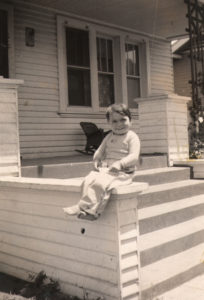
So, we drove around the block, to daylight on the same corner, and … THERE THEY WERE! A little girl — my sister about a year or so later — appearing to be taking her first wobbly steps and her mother — my mother long before I knew her — taking pictures with a big clunky camera.

Mr. Carraway’s big grin betrayed that he was
as thrilled with this time-travel stuff as I was. “Let’s try one more. Pick another one.”
I remembered an old family photo with a Mother’s Day story — “OK. another shot in the dark. Let’s try May 12, 1935, a Sunday afternoon.”
Around the block we went again and there was my sister in the front yard, a serious three-year-old all dressed up for Mother’ Day.
Of course, I had an almost overpowering urge to get out of the car, walk up to my mother and sister and introduce myself — wouldn’t that be something! But I recalled Mister Carraway’s caution when we first arrived: “… it would be very dangerous to interfere.” As I looked at this scene from long ago, I couldn’t help but wonder what would happen if I did ‘interfere.’ How much trouble would I cause? I imagined the obvious:, that I would risk changing the past. If that happened, I supposed it would change the future — that is, the “present” that I intended to return to back at the museum? The possibilities were immediately frightening and I forcefully put it out of my mind.
Mister Carraway interrupted my pondering — “OK, I think we got what we came for. This fancy car’s going to attract some attention. Doesn’t quite fit in with the neighborhood, if you know what I mean. We should head back.”
“Right. Mister Carraway, this has been incredible, so much more than I imagined possible.”
The ride back to Danville on that country road was pretty quiet. I had trouble finding words for the experience of visiting the 1930s. Looking at the house I loved as a kid, Nana’s house, long before I knew it, was simultaneously familiar and completely foreign. I had wanted to stop and talk to my young mother and “little” sister, walk up the steps where I used to pretend to speak to a cheering crowd (like I saw in the movies). I wanted to sit on the porch swing just as I had done as a kid in the 1950s; but, as Mister Carraway said, I would have been a stranger, an intruder.
On the ride back to ‘the present,’ I remembered with great irony, that my nephews and I used to sit in that porch swing in the late 1950s and exercise our lively imaginations. Visiting Nana’s house when I was nine and my two oldest nephews were seven and five, we pretended that the swing was a magic bus. We used to dial up where we wanted to go. We would sing a little jingle from a TV toothpaste commercial and it would take us wherever we wanted to go — just like this magnificent 1931 Packard had done “today.”
If only we had known.
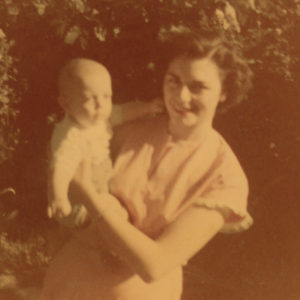

Baby Danny (me) and my sister Bunny Bunny, her husband Joe, and one of their sons,
in that front yard, 1950. Stephen, on one of several “Magic Buses” from that era.

Bunny, more recently
![]()
Filed under: Family Stories,Fiction,Time Travel | |3 Comments
The MAN: Lew Turns 68
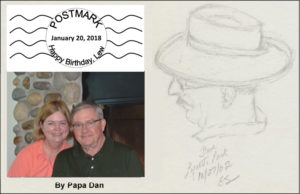
Lewis Frazier Bell: “The MAN”
An inspiration to us all.
Click here to download a PDF of this post: Happy_Birthday_Lew
= = = = = = = = = = = = = = = = = = = = = = = = = = = = = = = = = = = = = = = =
Happy Birthday, Luigi
On November 3rd, 1997, I wrote you a letter entitled “The MAN.” It was my attempt at expressing my admiration for you after knowing you for nearly thirty years. We met in the dorm at Santa Clara University in the fall of 1968 and you had been an inspiration to me ever since. Some time later, I was given the privilege of reading it to you at your birthday dinner.
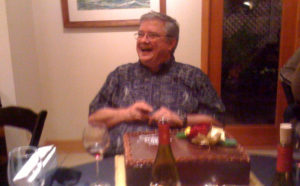
Sitting across the table,
celebrating your birthday.
You had written to me that you were taking two days off as a reward for working some long hours. You had been sick. Now that you were feeling better, you had a view of work I had not experienced. Here is the letter I wrote and read to you across the dinner table on your birthday:
Lew,
Good for you! I am glad that you are taking these two days off. You mentioned an idea that I had not considered: that right now you feel that you “get to do this.” I suppose it was exhilarating to do 14 hours at work for three weeks and breathe in the accomplishment of it — after so many months of recovering from being sick. When we are working too hard we dream of working “only” eight hours a day, five days a week. When we are not working at all we dream of being so valuable and so good at what we do that we have to work 14 hours a day. Perhaps you had to prove to yourself that you could do it again.
Well, I hope you have proven everything to everyone to your satisfaction and can settle into something more regular and sensible. You have proven to me (years ago, continually, and all over again) that you have a huge capacity for work and accomplishment — for quality and quantity, and more. You can dish it out, take it, and dish it out some more — you have stared this life in the face and shouted, “Give me more to accomplish, send me more hurdles to jump over, there, take that, and that; I can do it all, and then some!
Want me to become a valued professional? Done it.
Want me to raise a magnificent son? Done it.
Be part of a great family? Done it.
Maintain a long and solid marriage? Doing it every day.
Support, encourage and inspire friends? Done that too.
Make everybody’s life better because they know me? Done it. Doing it.
How about if I quit smoking? Done it.
Learn to make wine, great wine? Check.
How about learn to become a computer artist and photo designer in my spare time? Check.
Want me to beat cancer? Done it.
Want me to do it again? BRING IT ON! I’ll drink it dry, make some more, design a label, bottle it, and drink THAT dry!”
THAT’S what I have heard from you over these years, Lewis Frazier Bell. You can look this world in the face once again and say, “I don’t have to prove anything to anyone, including myself. I’m the MAN!”
And then, you can drive to work in Monterey and “experience the most beautiful morning . . . layers of pink and blue and white and yellow and rust and lime green and red and sand and aqua and purple and….. The day was perfect in Sand City.” [your words]
Drink deep, Luigi, you’re The MAN!
AND ME? I get to turn and look at that same world and say with pride:
“See that? That’s my friend.”
Dan
So, it’s your birthday again and it’s 2018
This year, you and I turn 68. Sixty-eight! Could we have imagined that, back in the dorm fifty years ago? But here we are. Since those days, we have a string of memories. Topping the list, you and your lovely wife, Rita, raised an amazing son — a giant of a man — a surgeon, a hero. All three of you were there with us at our wedding in Yosemite. You were there at many family events. You and Rita and Gretta and I went to Europe and visited Varenna, on Italy’s Lake Como, and took the train to Southern France. We ate some great food and drank some wine (it’s what we do), and I’ll never forget.

Dan & Gretta’s wedding,
Yosemite
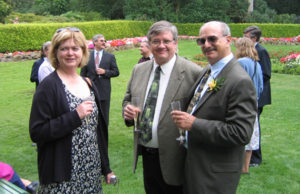
Ben’s wedding,
San Francisco

The terrace at Albergo Milano
Varenna, Lake Como, Italy
Thank you, Lew, for being you — Happy Birthday!
With Our Love,
Dan & Gretta
Filed under: Family Stories | |1 Comment
Words of Thanks
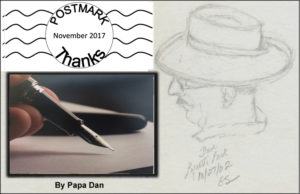
“And yet it moves”
(in the original Italian: “Eppur si muove”).”
— Galileo Galilei,
Gentleman of Florence, 1632
Click here to download a PDF of this post: ConVivio_Thanks_TheSun_Nov16_2017
= = = = = = = = = = = = = = = = = = = = = = = = = = = = = = = = = = = = = = = = = =
“The Sun, with all its planets revolving around it and depending upon it,
still can find the time to ripen a bunch of grapes
as if it had nothing else in the universe to do.” — Galileo Galilei, 1632
This line first captured my imagination when I saw it on the back label of a bottle of red wine (where else would I look for memorable, meaningful words, eh?). I was looking for some wine for our Thanksgiving dinner table, the family was going to be there, and I would be offering a Thanksgiving Toast — I thought these words were perfect.
When the time came, with the bottle in my hand I mentioned that we all have so much to be thankful for: our families, our homes, the work we do, the people who are kind to us, the food and wine we enjoy, and the good times we have. Then, using Galileo’s words, I gave thanks for The Sun, representing all of the ‘greater powers’ that contribute to all of that goodness — whatever and whomever they might be. The words were fun, appropriate to the occasion, and they brought smiles. We lifted our glasses and said “Thanks’ to each other.
Galileo’s words helped us do that.
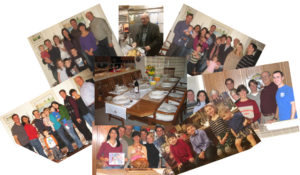
A Random Bunch of Thanksgiving Photos
Galileo’s Words In Context
So, if we let our minds drift back 385 years to Galileo’s time, we learn that he caused quite a kerfuffle, to say the least, when he first used these words. In a nutshell, in 1633, the Roman Inquisition wanted to torture him to death for saying these words. WHAT!!!??? Looking back with our 21stt-century eyes, it seems unlikely that the church fathers objected to the generous role of the Sun in producing wine grapes. And I suppose they weren’t threatened by the assertion that the Sun was capable of this level of multi-tasking. So, what was the problem?
The offense was that Galileo contradicted the church’s insistence that the Earth stands immovable at the center of the universe and that the Sun, and everything else, moves around the Earth every day. The Roman Inquisitors decided that Galileo’s conclusion, that the Earth moves, threatened the absolute power of the church. They said that his words were “foolish and absurd in philosophy, and formally heretical since it explicitly contradicts in many places the sense of Holy Scripture.” THAT was serious — serious enough to put Galileo on trial for his life.
So, how did it turn out? The outcome, seen through 21st-century eyes, was quite familiar. First, Galileo made the intellectual case. He said, initially, in his defense before the Inquisitors:
“I do not feel obliged to believe that the same God who has endowed us with senses, reason, and intellect has intended us to forgo their use and by some other means to give us knowledge which we can attain by them.”
In other words, does God really want us to deny what our “God-given” intellect reveals to us? In his treatise “Dialogue Concerning the Two Chief World Systems,” he went a bit too far:
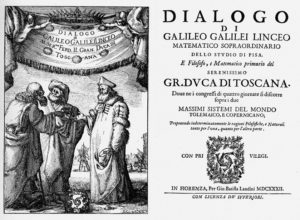
“In the long run my observations have convinced
me that some men, reasoning preposterously, first
establish some conclusion … that impresses them
so deeply that one finds it impossible ever to get it
out of their heads.”
— from Galileo’s: “Dialogue Concerning the Two Chief World Systems”
Does that sound familiar? Well, as you might imagine, that approach failed. The Inquisitors made clear that these two arguments would lead directly to his torture and death. So, Galileo took another approach. He did exactly what he said he “did not feel obliged” to do — he denied what his intellect revealed. First, he admitted that he had, in fact, published a book that contained the offensive “false opinion.” He said that, despite the fact that he had presented “arguments of great cogency in its favor,” he settled the matter with the following statement:
I have been pronounced by the Holy Office to be suspected of heresy, of having believed that the Sun is the center of the world and immovable, and that the earth is not the center and moves. Therefore, … with sincere heart and unfeigned faith I abjure, curse, and detest the aforesaid errors and heresies, and generally every other error, heresy, and sect whatsoever contrary to the said Holy Church, and I swear that in the future I will never again say or assert, verbally or in writing, anything that might furnish occasion for a similar suspicion regarding me; but that should I know any heretic, or person suspected of heresy, I will denounce him to this Holy Office. Further, I swear and promise to fulfill and observe in their integrity all penances that have been, or that shall be, imposed upon me.”
So, that was THAT. Even in translation from the original Italian, it was a clear denial.
Well, modern scholars have re-examined the events of the time — notably David Hilbert who wrote in his defense of Galileo’s recantation:
“Galileo was no idiot. Only an idiot could believe that science requires martyrdom. That may be necessary in religion, but, in time, a scientific result will establish itself.”
Witnesses at this historic session with the Inquisitors reported (quietly, and to a select audience) that, after Galileo saved himself by admitting that the Earth does not move from its place at the center of the universe, rising from his knees to begin his house arrest, he was heard to mumble:
“Eppur si muove — And yet it moves.”
Finally, 359 years later, the Church agreed. At a ceremony in Rome, Pope John Paul II officially declared that Galileo was right. The formal rehabilitation was based on the findings of a committee the Pope set up in 1979. After a 13-year investigation, they decided that the Inquisition had acted in good faith, but was wrong. On October 31, 1992, a papal statement appeared in the New York Times:
“We today know that Galileo was right in adopting the Copernican astronomical theory.”
Oh, good for you!
What Did It Mean in 1633?
Was it a confrontation between science and faith? Historians and analysts over the past four centuries have said “No,” because Galileo never presented his science to the Inquisition. ‘Science’ wasn’t even present at the trial. It was about authority, at a time when the Protestant Reformation, at its peak in the 1630s, had questioned the whole notion of legitimate sources of authority. It wasn’t about the content of the science, or even logic; it was about “Who says?”
Little did any of them know, science would eventually have the last word. While the church insisted that the earth stood motionless at the center of the universe and Galileo reasoned that the Sun stood motionless at the center — turned out that not only is the Sun not still, everything is swirling around in a giant blender more vast than any of them imagined. Who knew?
Does It Mean Anything Today? (i.e., my usual “So what?” question)
Some have suggested that a similar “Who says?” argument is being waged today over matters in which science contradicts the sacred interests of today’s prevailing powers. Those folks argue that today’s arguments matter significantly more than the one that Galileo nimbly sidestepped back in 1633. Perhaps we’ve learned three things (there are always three): 1) that every age feels that its own struggles matter more than any that have gone before, 2) that such “Who says?” struggles are not likely to end any time soon, and 3) our experience teaches us that the right answer does eventually prevail. Once again, “the scientific result will establish itself.” In the meantime, the Sun still rises in the morning, it still does its important work in the vineyards and elsewhere, and it sets every evening, all as it is supposed to do. Often, though not always, that behavior continues without a lot of trouble for us humans. And for THAT, we may be thankful.
My Thanksgiving Toast Still Stands
“The Sun, with all its planets revolving around it and depending upon it,
still can find the time to ripen a bunch of grapes
as if it had nothing else in the universe to do.” — Galileo Galilei
I am thankful to THAT goodness for giving us all that we are and all that we have, especially each other. So many are not so fortunate and yet we have so much.
Happy Thanksgiving to you and yours!
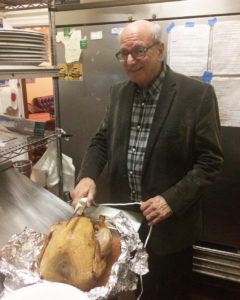
The Turkey!
![]()
Filed under: Family Stories,Ideas,Who We Are | |8 Comments
Not So Long Ago
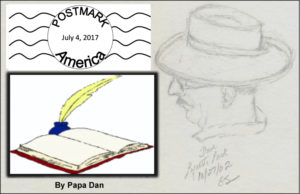
My Dad was born on October 10, 1910
(some friends called him “ten-ten-ten”).
Today would be his 107th 108thbirthday.
He was a storyteller;
so, let’s tell some of HIS stories.
— DRS
This post is best read on a large screen or in the PDF.
Click here to open a PDF of this post (best for printing and easier to read): Not_So_Long_Ago_100817_FINAL
= = = = = = = = = = = = = = = = = = = = = = = = = = = = = = = = = = = = =
Origin of a Storyteller — Not So Long Ago

A coal-miner’s son, he was hauled from West Virginia as an infant to the vineyards and prune yards of California’s Santa Clara Valley.
He was fourteen when this picture was taken on December 4, in 1924 — the third son of illiterate immigrants from Reggio di Calabria, in southern Italy — when he was pulled out of the 8th grade to work with his brothers on their “share-cropper” farmland in Morgan Hill to survive the hard times.
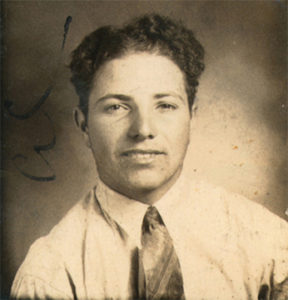
By the time Umberto, known as Al, turned sixteen in 1926, he took a 30-mile train ride with his brothers to Pittsburg, California, to lie about his age and get a job in the steel mill. He and his older brothers Giovanni (John) and Giuseppe (Joe) supplemented their income as singing waiters at Cippolini’s restaurant down by the river. According to the story, they sang “Italian opera.” Just where and how they learned anything about Italian opera is a mystery.

By the age of twenty, Al had taken a shine to a 16-year-old beauty named Domenica (known as Memi). Her family was from Isola delle Femmine, Sicily (the same town that gave us their cousins of the baseball-famous DiMaggio family). In the fall of 1931, she was kicked out of her house by her abusive father and, with nowhere else to go, went to Al’s house and told him her story. He immediately did the obvious thing (to him): borrowed a car and $50, drove them to Reno, got married, rolled the car down a hill on the way back, and took a bus home.
And, so it began.
Al and Mae welcomed their first child in the fall of 1932 — Anita Mae, known as Bunny. As war production began in the 1940s, Al, now known as A.J., went to night school to resurrect his aborted 8th-grade education and became a mill foreman. When steel production began to decline with the end of the war, he studied the insurance business at night and that he had a talent for salesmanship.
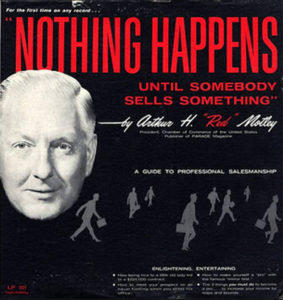
He bought a record player and some 78-rpm Cole Porter records; but he quickly focused on recordings made by Dale Carnegie, “How To Win Friends and Influence People,” and, later, his favorite, “Nothing Happens Until Somebody Sells Something,” by Arthur “Red” Motley.
With the promise of a new prosperity at the beginning of the 1950s, Al applied his persuasive skills to the task of convincing his friends and neighbors that they needed to leave something for the next generation. The result was a lucrative second job selling life insurance. By the time his second child, Danny, arrived in 1950, a sign went up at 616 Black Diamond Street that said, ”A.J. Sapone Insurance.” He said goodbye to the steel mill and never looked back.

From his salesmanship recordings, he learned about the key role of advertising and developing a storytelling “hook” on which to build a business that would attract “the most important people in the world: customers.” He decided that his “hook” would be the immigrant legacy of his town in his effort to become “the man to see” about the various types of insurance policies that were quickly becoming the foundation of life in the second half of the 20th century. So, once again, he did the obvious thing (to him): he joined the Pittsburg Historical Society, became its president, and began a collaboration with Milton and Claudia Killough to write the history of Pittsburg.
By the Spring of 1961, Al had collected some stories to tell and began writing a short newspaper column in the local newspaper (OK, so it was an advertisement). He called it, “Not So Long Ago.” He found ways to connect those stories to the need to be “covered” in all the ways the fledgling “modern world” would require. His goal was to make enough money to do three unthinkable things for an uneducated son of immigrants – buy his wife a mink, buy himself a Cadillac, and send his son to an expensive college. (Since you asked, oh yes, he did those things.)
So, a new chapter began — this time it was about storytelling.
Al’s newspaper advertisements were approximately 3.5 x 5.25 inches on the page and appeared about once a week. Here are a few examples, enlarged here so you can read them, if you like.
On May 19, 1961, Al published a story about the founding of Pittsburg, dropping the names of well-known local families and emphasizing the importance of this little industrial town. The story went on to praise the enduring work of the town’s founders in its first decade.

Each story would end with the all-important message: that the right insurance policies are essential to ensure the future prosperity of his friends and neighbors. This one said:
Our General Continuous Homeowners policy will serve you well. Come in at your leisure and let us tell you of this outstanding policy that will save you money and give you the best coverage.
In another story, Al described the event that eventually gave the town one of its names and put the town “on the map” — the discovery of coal in 1855. The story went on to praise the abundance of coal produced in this mine’s 42 years of operation and looked back with nostalgia at the remnants of their coal-mining legacy.

AND, it ended with the usual punchline:
“General of America and Safeco will make a lasting impression in your insurance history — stop in and let us tell you about this NEW and EXCITING HOMEOWNERS INSURANCE COVERAGE.”
In yet another story, he reached further back to the 1830s to recount the origins of Pittsburg, sixteen years before the discovery of coal put the town “on the map.”

—> The advertisement flowed (mostly) from the story:
Whether you are an old or new resident of this colorful community, it will pay you to stop by our office and let us tell you of our NEW AND MODERN GENERAL OF AMERICA continuous Homeowners policy. All in one policy and one policy for all your insurance coverages, and at a savings. Next week we will tell you about the Coal Mine Era, not so long ago.”
Before the turn of the century, saloonkeepers establish for themselves a place of prominence in the community as the town is renamed “Black Diamond.”
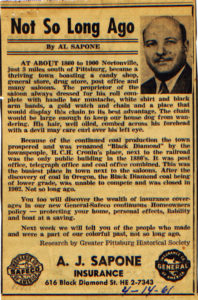
And then … the punchline:
“You too will discover the wealth of insurance coverages in our new General Safeco Continuous Homeowners policy, protecting your home, personal effects, liability and boat at a saving.”
Next week, we will tell you of the people who made and were part of our colorful past, not so long ago.”
Then, one week later, as promised, we learned about some of the early characters who were ancestors of the current citizens who read these stories in April of 1961:

Let’s skip ahead to the early 20th century — 1911 — a time when local businesses began to compete with the coal mine as a source of prosperity. Some of the same local names from the previous century continued to be part of the story.
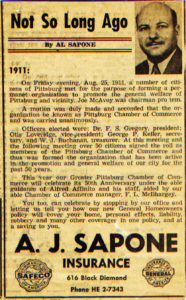
Then came the advertisement:
You too can celebrate by stopping by our office and letting us tell you how our new General Homeowners policy will cover you home your personal effects, liability, robbery, and other coverages at a saving to you.”
One more — this one looks back to 1941:
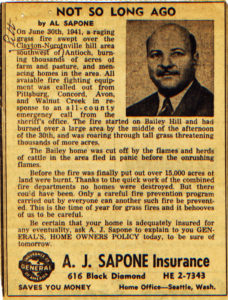
—->And then the commercial:
Be certain that your home is adequately insured for any eventuality, ask A.J. Sapone to explain to you GENERAL’S HOME OWNERS POLICY today, to be sure of tomorrow.

As the stories progressed, those who are
familiar with Pittsburg (I know there are a
couple of you out there) will notice that the
names of many of the founding characters are
immortalized on street signs throughout the
town as it exists today. Here’s an example
(it was named for my uncle John after he
passed away in 1935).
One more thing — if you had walked into the office at 616 Black Diamond Street back in the Spring of 1962, you would have seen this full-sized magazine on the desk:
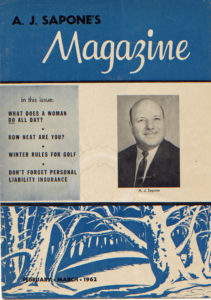
The articles in A.J. Sapone’s Magazine praised the productivity of the women of the early 1960s, offered advice to promote neatness, suggested some “Winter Rules for Golf” (he never played golf), and, of course, reminded us to make sure we were properly “covered.”
So, this is the story of how an uneducated son of illiterate immigrants from the toe of the boot of Italy — a coal-miner’s son — built a life on a foundation of storytelling. It turned out that there was more storytelling where that came from (perhaps, for another time); and it all started with a simple idea: “Nothing happens until somebody sells something.”
A.J. Sapone in 1970 on his 60th birthday
Filed under: Family Stories,Who We Are | |12 Comments
Unexpected Wisdom
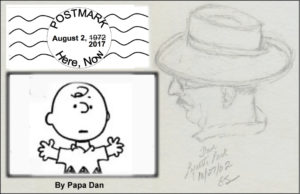
“It is important to make plans for the future,
as long as you are prepared to change them
when the future comes.”
— Albert J. Sapone, 1970
Click here to download a PDF of this post:
63-Unexpected_Wisdom_August 3_2017
= = = = = = = = = = = = = = = = = = = = = = = = = = = = = = = = = = = = = = = = = =
This cartoon first appeared August 6, 1972 — Charles Schultz
When I cut this cartoon out of the San Francisco Chronicle on August 6, 1972, the world I knew was changing dramatically. Two months before, I had graduated from Santa Clara University with my double major in English Literature and Philosophy. Less than a week before it appeared, Woodard and Bernstein published their first in a series of New York Times reports about a “third-rate burglary” that would lead to Richard Nixon’s resignation two years later. The week the cartoon appeared, I was hired into my first professional job. And that summer, for the second year in a row, no record albums were released by a band called “The Beatles.” All were milestones of change that felt dramatic and disorienting, or at least a bit uncomfortable; but looking back, they were really just inevitable extensions of what had gone before — just like the scene in the Peanuts cartoon.
So, aren’t these the kinds of things every generation experiences — when the conditions of stability we had learned to expect, no longer seem to apply? Kinda universal experiences, aren’t they? Yet, I suspect that each one of us felt — and feels — that our own experience with discomforting change is more or less unique to us. Does Charlie Brown’s warning matter? What does it mean? Here’s where I ask my “So what?” question.
I do remember the security of sitting in the back seat — my parents took me to the Drive-In movies from time to time. I’m pretty sure I saw the “Ten Commandments” with Charlton Heston at the Bridgehead Drive-In, in the back seat of my parent’s 1956 Oldsmobile.; I remember eating popcorn, drinking Coca Cola, and having the option of lying down if I got tired or bored (which I’m pretty sure did — I was six years old). I don’t remember noticing, or regretting when that practice went away. In the cartoon, Charlie Brown shows some remarkable prescience to be able to report to Peppermint Patty that those days of “security” would end. Nobody warned me, so I guess I didn’t notice. Did anybody warn you? What do you remember?
I suppose starting a new school — especially high school — was a big transition, but my memories of those transitions are positive. I was good at school and it wasn’t intimidating. Going away to college was a bigger challenge. But, it wasn’t the “college” part; it was the “going away” part that was disorienting.
While graduating was a triumph, it did carry some anxiety. Not the graduating part — my Dad had told me early and often that I was going to be the first in my family to graduate from college whether I wanted to or not. That part was expected; and I had no reason to doubt it. But one aspect of it was a deviation from long-held expectations. My Dad had hoped that I would graduate with a degree in business (I arrived as an Economics major) so I could take my place in the insurance business and he could hang an ”And Son” sign under the “A.J. Sapone Insurance” sign out in front of his office. BUT … during my sophomore year, I came to realize that studying business didn’t generate the kind of excitement in me that Literature and Philosophy did. I wanted to change my major, but before I could do that — and study words and ideas instead of dollars and cents — I figured there was a hurdle I had to overcome …
I went home for the summer and told my Dad all about literature, music, and philosophy and why I thought it all mattered so much. Then, I took a deep breath and told him that I didn’t want to be an insurance agent. I told him maybe I could become a teacher or a writer. I expected to have an argument on my hands, since the “And Son” story had been his dream; and I expected, frankly, to lose that argument. My Dad hadn’t finished the 8th grade and his struggle to make it had been impressive. He had told me all my life that I needed to get an education so I wouldn’t have to struggle. He had been proud to provide that ”back seat” of security for me as I grew up. I didn’t think he’d appreciate my interest in Shakespeare, Bach, and Heidegger. But, as great teachers often do, he surprised me. After a moment, he said (as if he had rehearsed it):
“It is important to make plans for the future;
as long as you are prepared to change them when the future comes.”
Then he said, “So tell me more about that Heidegger guy.”
Now, fast forward two years to 1972 — graduating with this particular degree, without an obvious “next thing” waiting for me, was a little like Charlie Brown‘s face in the cartoon …
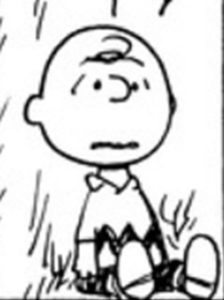
The future was all up to me, for the most part,
and the rest of the world had no responsibility to make it work out all right.
The days of sitting in the back seat of my parent’s ’56 Oldsmobile
were long gone.
So, being out in the world was an adventure; but it was “the ‘70s” and I do remember being told — in movies and popular music — that it was supposed to be an adventure.
I liked Helen Keller’s line: …
“Security is mostly a superstition. It does not exist in nature,
nor do the children of men as a whole experience it.
Avoiding danger is no safer in the long run than outright exposure.
Life is either a daring adventure, or nothing.” — Helen Keller
As scary as it was, the adventure turned out all right. A teaching job materialized when I needed it, followed by a long career as a writer and editor. That was, frankly, the easy part. Today, the world is still changing dramatically, just as it was in 1972. The disarray of politics and the evolution of our musical heroes will continue to be part of that adventure for a long time. Heck, we are even likely to survive the adventure our government is providing today, as scary as it seems — AND, yes, Paul McCartney is still making music.
And Now, “So What?”
For me, and for many of you, the REAL challenge came with the arrival of children. Providing a “back seat” for my own young children “to fall asleep in” was clearly my responsibility. I came to realize that the great challenge of modern life may not be so much the fear that Charlie Brown and Peppermint Patty felt as they looked ahead to an uncertain future — they didn’t know it, but they would overcome it all just fine in their own good time. The challenge resided in the characters that we never met in Charles Schutz’ comic strip — the parents. That challenge in my own story rested with my Dad. At that time, he could have derailed my plans; he could have insisted that I complete my degree in the school of business and fulfill his “And Son” dream
— he was, after all, paying the bills. His wisdom was to give me permission to pursue the “daring adventure” that Hellen Keller spoke of. He had to take the risk that I could succeed going my own way. For that, I thank him today.
Recently, in a conversation with my son Matt about raising children (as he and his brothers are doing so well), he reminded me of something I quoted to him years ago from a book I read (“How To Father,” by Fitzhugh Dodson). The book asked, what is it that children, whether they know it or not, want most from their parents while they are growing up? The answer:
“Risk with me while I’m trying on selves.”
“Risk with me while I’m trying on selves.”
I didn’t see that in the comic strip all those years ago; but today, as I look with admiration at children and grandchildren, just like those in the cartoon, I see that as the enduring message. ![]()
Filed under: Family Stories,Ideas | |5 Comments
It’s Spring, It’s Baseball, It Must Be Arizona
 A Field, In Your Dreams —
A Field, In Your Dreams —
“And they’ll walk out to the bleachers; sit in shirtsleeves on a perfect afternoon. They’ll find they have reserved seats somewhere along one of the baselines, where they sat when they were children and cheered their heroes. And they’ll watch the game and it’ll be as if they dipped themselves in magic waters. The memories will be so thick they’ll have to brush them away from their faces.”
— Terrence Mann
(James Earl Jones in “Field of Dreams”
Matt: Dad, you’ve been a Giants fan since you were eight;
how come you never went to Spring Training?
PapaDan: I dunno. Just never got around to it.
Nou: We can fix that.
So, it’s March, 2016. I’m almost 66, a month or so from retiring from a long career, and my son Matt and his wife Nou have brought Gretta and me here to Scottsdale, Arizona, for my first visit to Spring Training. It’s a gift: a combination of Christmas, birthdays — Matt’s, Gretta’s, and mine — and my retirement. And, oh, what a gift!

I raised my sons to be Giants’ fans and we went to a lot of games, in Candlestick and then AT&T Park. (OK, so we also went to a bunch of Oakland A’s games at the Coliseum, — I even have one of those “half-A’s, half-Giants” hats from the first Bay Bridge Series, but let’s not be spreading that round, eh?) Baseball has always been part of our lives, from my own childhood in Antioch to the day we took my first grandchild, Matt’s daughter Ruby, to her first Giants’ game in 2005 against the Dodgers in San Francisco. But the true heart of baseball wakes up from Winter in Arizona — The Cactus League — where the pitchers and catchers report early, the young players bring their wild hopes, and every dream of every player and fan seems possible, maybe even likely, with the first crack of the bat. There’s magic.
“Well, you know I … I never got to bat in the major leagues. I would have liked to have had that chance. Just once. To stare down a big league pitcher. To stare him down, and just as he goes into his windup, wink. Make him think you know something he doesn’t. That’s what I wish for. Chance to squint at a sky so blue that it hurts your eyes just to look at it. To feel the tingling in your arm as you connect with the ball. To run the bases – stretch a double into a triple, and flop face-first into third, wrap your arms around the bag. That’s my wish, Ray Kinsella. That’s my wish. And is there enough magic out there in the moonlight to make this dream come true?” — Dr. Archibald “Moonlight” Graham
Scottsdale Stadium
Scottsdale Stadium is perfect. It has room for just 12,000 people. Its natural-grass field has been the Springtime home of the San Francisco Giants since it was built in 1992, on the site where the old Scottsdale Stadium stood since 1956. Its ten-foot fence is 360’ down the left-field line, 330’ down right, and 430’ in straightaway center. Perfect.
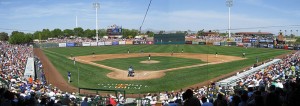

Once again, this Super-Classy Giants organization shows MLB how things should be done. Behind the fence, from the left-field corner to right-center, there is a berm – a large, deep-green lawn-covered hill and picnic area where fans of all shapes and ages are arrayed on blankets on the field side of the berm – with a clear view of the entire field.
Behind right field – Wow! — the split-level “Charro Lodge” has a covered pavilion with a large patio. You can sit there by adding a hundred dollars to your ticket price – all food and drink included! The money goes to a local charity, managed by volunteers, called The Scottsdale Charros,” which has run spring training for the city since 1964. (Next year – I’m there.)
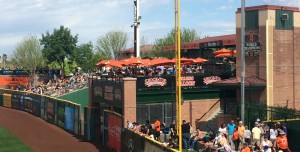
My friend and Spring Training aficionado, Richard Ward, told me what to expect from Scottsdale: the sweet scent of orange blossoms by night; the aroma of creosote bushes by day, green-barked trees everywhere, bougainvillea along the freeways, and restaurants suitable for a range of tastes — on example:
Honey Bears BBQ
“Don’t need no teeth
To eat our meat”
Turns out that there are restaurants for other tastes as well. My daughter-in-law Nou introduced us to some culinary delights with two remarkable reservations:
EVO (lobster Risotto, fennel sausage in magic pasta, amatriciana)
On N. Goldwater Blvd., Scottsdale
The Salty Sow (roasted porchetta, trout almandine, duck fat fritters)
On East Cactus Road, Phoenix
But, let’s now forget — the most important meal at the ballpark is the traditional ‘beer and a dog.’ My choice was the ‘Giant Dog’ and a Sierra Nevada Pale Ale.
What’s It All About, Really
Spring Training is, first and foremost, pure baseball. But the unique feature that sets it part from the 162 games of the MLB regular season is a seeming contradiction: the games in March in Arizona do not count for anything! BUT for the players, the games matter a great deal. For the veterans, the task is to get ready for Opening Day back home when every game counts. Sandy Koufax famously said, “Anyone who thinks Spring Training doesn’t matter has never tried to throw a baseball.” This weekend, one player caught my attention and demonstrated that the games matter. I didn’t remember the name Jarrett Parker before Saturday — I had to look up his #6 in the program. This 27-year-old lefty got my attention when his third-inning home run put the Giants on the scoreboard for the first time. Then over the rest of the weekend, he made some remarkable plays in right field, including back-handing a base hit down the line and throwing a ‘rope’ on one hop to Buster Posey from the right-field corner. Turns out we saw him play last year with the Sacramento River Cats where he hit .283 and hit 23 home runs. The word is that his performance in Spring Training last weekend is causing a ‘problem’ for the Giants. Looks like they are going to want his glove and his bat in the lineup on Opening Day — so, to do that, which one of their existing outfielders will he replace? I guess the games in Arizona the rest of this month will answer that question. So, don’t tell any of them that Spring raining doesn’t matter.
For those of us on the lawn behind left field, Spring Training isn’t only about the future. Spring Training seems to be designed to bring back baseball the way it lives in our memories of the past — our own past. This past weekend, my son Matt and I did our best to live in that moment as we leaned up against the beer stand on the left-field lawn. We told each other stories — reminded each other, really —about long-remembered days at major-league parks from his childhood, and that of his brothers, and my own. In that setting, the baseball memories poured out like the beer from the tap when the handle is pulled at the beer stand behind us. Memories like these:
- When Matt and his brothers were kids and we sat in the ground-level seats behind left field in Candlestick Park (he remembered that those seats cost $2.50 each) watching Will Clark come to bat wearing his famous “Nouschler” — that was the name he gave to his most intense “game face,” reserved for only the most intense situations with men on base — and then waiting for him to unload one of his screaming line drives in our direction down the right field line. (Matt remembered the name of the “Nouschler.”)
- Or when I was eleven years old and my brother-in-law Joe Faletti took my nephews and me to our FIRST Giants game in 1961. It was the day when I learned THE hard truth about baseball – that even on a momentous day like my first Giants game, “we” didn’t always win. Even after 55 years, I remember that the Pittsburgh Pirates beat my San Francisco Giants 4-3 that day. I loved it anyway. And how could I not, with a lineup that included Willie Mays in center, Willie McCovey in left, Felipe Alou in right, Jim Davenport at third, José Pagan at short, Chuck Hiller at second, Orlando Cepeda at first, Tom Haller (or Ed Bailey) behind he plate, and Juan Marichal or Jack Sanford on the mound? How many times had I told Matt the story? (Matt had heard it before, but I carefully listed that lineup again.)
- Or, that same 1961 day, when we stood on the blacktop behind right-field fence and my nephew Steve ’caught’ (after one bounce) a batting practice home run off the bat of Willie Stargel. Yes, I told that one again, too.
- Or, on another Candlestick day from my childhood, when my nephews and I stood behind that same chain-link fence, in awe at the fact that the hero of all heroes, Willie Mays, was standing in centerfield, tapping his glove not more than twenty feet or so from us — what a thrill THAT was!
- Or, again, when my sons were young, watching the Oakland A’s at the Coliseum (OK, I admit it, we watched the A’s sometimes) the day Roger Clemens was ejected from the game and, before leaving the dugout, heaving the large orange Gatorade jug onto the field in one of his fits of rage.
- Or, on October 7, 2001 at AT&T Park when Matt’s brother Ben and I watched from nine rows behind the Giants dugout as Barry Bonds’ 73rd home run that season sailed over the fence in straightaway center field.
- Or, even in my back yard as a kid listening to Russ Hodges on the radio shout “Bye, Bye, Baby!” when one of my heroes hit one out of the yard, or Lon Simmons with his own call “You can tell it Goodbye!”
- Or, the day in 2005 when a bunch of us brought my first grandchild, Ruby, to HER first Giants game. Click this link for a PowerPoint story of that day (it loads in about 30 seconds). –> –-> Ruby_Giants_09_17_05_edit
The third important purpose of Spring Training is to create new memories. Scottsdale Stadium contains some special characters worthy of our memories, special spirits who live only there — the lemonade vendor in the bleachers was selling “Lemonade Like Grandma Made.” Take a listen/look (the 8-second movie may take 30 seconds to load)
–> –> –> Lemonaide_like_Grandma_made
Where Was I?
Where was I? Oh, yeah, it’s 2016, it’s Spring Training, I’m a week away from my 66th birthday — where has the time gone? It has been such a joy to have spent some of that time at the ballpark. Base Ball (as James Earl Jones pronounced it) walked along beside us all the way from there/then to here/now.
Yes, here at Spring Training, thanks to this gift from my son and his wife, the memories are thick and sweet, memories from decades ago or from yesterday afternoon, from my own childhood, that of my sons, or my grandchildren.
Yes, we’re all children together at the ballpark.
Finally, some of you will remember, from another field, a conversation between a father and a son from the edge of an Iowa cornfield:
John Kinsella (to his son): Is this heaven?
Ray Kinsella (to his father): It’s Iowa.
John Kinsella (to his son): Iowa? I could have sworn this was heaven. [starts to walk away]
Ray Kinsella (to his father): Is there a heaven?
John Kinsella (to his son): Oh yeah. It’s the place where dreams come true.
[Ray looks around, at his field, his wife and daughter on the porch]
Ray Kinsella (to himself): Maybe this is heaven.
Thank you, Matt. Thank you, Nou.
Click here to download a PDF of this article: FINAL_SpringTraining_ConVivio ![]()
Filed under: Baseball,Family Stories | |2 Comments
ConVivio Celebrates — Welcome to the World, Madison
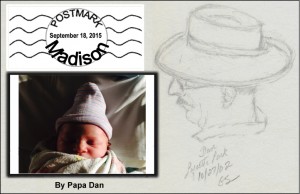 New photos (after seven weeks) have been added below.
New photos (after seven weeks) have been added below.
September 18, 2015 — Today we say hello to the newest member of the family. Her name is Madison and she is our seventh grandchild!!!
By the way, she is stunningly beautiful, but you knew that, eh?
She is already writing her own story, with the loving and wise guidance from her proud parents, William and Maria.
My first observation, right after noticing the she is beautiful (did I mentioned that?), was that she seems remarkably calm and composed. She opens her eyes from time to time (“Who are these intersting people?” she wonders), fiddles with her fingers (“Wonder what these are for?”), and says a few brief epithets of commenatary — until her attention is diverted by her PapaDan’s melodious humming of his favorite baby pacifier “Let Me Call You Sweetheart.” She quickly closed her eyes and returned to her “calm and composed” posture. I figured she was soothed by the sheer musicality of my rendering of the tune, (others in the room suggest that I may have bored her back to sleep, a credible suggestion that I quickly rejected).
ANYWAY, needless to say, we are all thrilled. Gretta and I had the privilege of sharing this first afternoon of Madison’s life with another pair of her grandparents (Momma Maria’s parents), Manny and Diane, and course Madison’s spectacular parents Maria (who had just completed 36 hours of labor) and my son William (who was proudly wearing his new “Best Daddy. Ever.” T-shirt).
Below are a handful of pictures from Madison’s first few hours in her well-appointed suite in the sparkling, new Kaiser hospital in Redwood City. More will be added, as they arrive.
Welcome to our family, Madison!
◊◊◊◊◊◊◊◊◊◊◊◊◊◊◊◊◊◊◊◊◊◊◊◊◊◊◊◊◊◊◊◊◊◊◊◊◊◊◊
.
And — last but not least:
Manny’s cigars and Diane’s Cupcakes!
◊◊◊◊◊◊◊◊◊◊◊◊◊◊◊◊◊◊◊◊◊◊◊◊◊◊◊◊◊◊◊◊◊◊◊◊◊◊◊
Below: Will sent some new photos from Madison’s first day.
Does the little sleeping face in the picture on the right look familiar?
A wonderful day to be born!
◊◊◊◊◊◊◊◊◊◊◊◊◊◊◊◊◊◊◊◊◊◊◊◊◊◊◊◊◊◊◊◊◊◊◊◊◊◊◊◊
A fond send-off from the hospital staff AND Madison’s first car ride!
Two Weeks Old!
Mommy Maria and Madison after two weeks
Uncle Ben and Madison
Face-painted Quinn holds Madison and Binky
Big eyes and a smile
Seven Weeks Old!
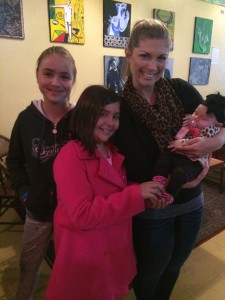 Madison’s first visit to The Flying Pig
Madison’s first visit to The Flying Pig
(with Mamma, Ruby, and Lily)
Other Madisonia on November 12:
Talking with Daddy:
And, of course, sleeping!
Download a PDF of this celebration!: Celebrating_Madison_Sep19_2015
Filed under: Family Stories | |2 Comments
Yosemite’s Vernal Falls: Once Again and Still
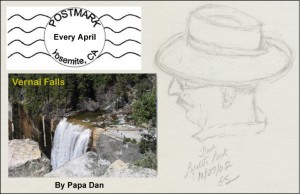 The First Time
The First Time
The first time was about 45 years ago. It wasn’t my first time in Yosemite National Park but, still an undergraduate at Santa Clara University, some older college friends determined that my education would not be complete until I hiked up to the Vernal Falls Bridge, climbed the slippery stone stairway up the Mist Trail to the top of the falls, to see (and hear) the world from there. It wasn’t really an “I dare you” kinda thing; it was more like: “You’ve never done that?!” They appeared to be stunned. My cousin Jim, his wife Cookie, and their friends Tim and Mike often advised me of the things that I MUST experience as I followed them through the Santa Clara University experience. This hike up to Vernal Falls was apparently one of those.
My answer was simply “OK.” In the presence of my ‘elders,’ I had learned to do what I was told.
Following one of Jim’s many specific instructions (he was four years ahead of me and had been my idol since I was a kid), I had completed his academic prerequisite to the Vernal Falls experience the previous quarter. When I was a freshman (and he was in graduate school), he made it clear that I needed to take Dr. Nyquist’s “Introduction to Classical Music” course as a elective. “Why?” I wanted to know.
“Because Dr. Nyquist won’t let you take his upper-division “Bach” class unless you have taken his ‘Intro’ course; and you have to do that.”
“Oh, I see.”
I was told to become familiar with Bach’s Toccata in F Major. Jim and his friends had decided, after hearing Dr. Nyquist play this challenging piece on the organ, that it should be called “The Waterfall Toccata.” They said I would understand when I stood beside the top of the falls on the rocks of the Mist Trail.
I was also told what to do when I arrived at that required destination: “Let your eyes follow the water from the top where it explodes out of the Emerald Pool all the way to the bottom. Watch the water tumbling down in free fall, merging with other spouts of water and then dividing into smaller rivulets as it splashes and bounces off the rocks all the way down, until it joins the larger turbulent pool constantly forming and re-forming at the bottom. Then, let your eyes follow the water back to the top and repeat the path back down. Then, tell me what you hear.”
Sure enough, Bach’s Waterfall Toccata is the soundtrack of Vernal Falls. Try it! [iTunes will sell you the classic E. Power Biggs performance of this piece for ninety-nine cents — or you can just listen at the link below.]
Last Time: Was It Really Ten Years Ago?
Every year since late in the previous century, Gretta and I have visited Yosemite during the first week of April celebrating our April 4 wedding anniversary. During our 2005 visit, we sat one afternoon beside the Merced River on the valley floor (a typical behavior for us — she drawing pictures in watercolor and me scribbling in a notebook). We convinced ourselves that we were still young enough to hike up to the source of this meandering stream (“How long could it take, really?”). So, the next morning we put on daypacks and took the shuttle to Happy Isles to begin the up-and-down hike (OK, it was mostly up) to the Vernal Falls Bridge; but we didn’t stop there (remember, we were ‘young enough’ back then). Past the bridge, we continued along the John Muir Trail to an amazing spot where you can look at both sources of the Merced River. From that spot, you can look down at Vernal Falls and up at Nevada Falls, while standing on the same rock. [Take a look at https://convivio-online.net/?p=185 for THAT story (“A Place To Stand, A Moment To Savor”).
But I digress . . .
Fast-Forward To Today — April 4, 2015
By this time I have drifted past my 65th birthday, ten years have passed from that day Gretta and I were “young enough” to undertake our adventure up above Vernal Falls and we are here in Yosemite once again celebrating our special day. This time, one of our sons and his wife, Matt and Nou, are here with us. Gretta’s sensitive back prohibits a repeat hike up to that rock; but the ‘young-uns’ offered to escort me up the mountain (presumably to make sure I survived), so off we went.
So, ten years on, what was different? What was the same?
First thing: I had no intention of hiking as far as Gretta and I had gone a decade before — that had required four-plus hours of endurance — that would be for the ‘young enough’ folks to do. My goal was to make it to the Vernal Falls Bridge, just close enough to find out if Bach’s Waterfall Toccata was still the sound track of the falling waters and to get a good photo (evidence of my accomplishment).
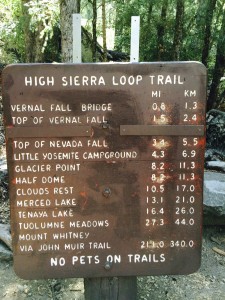 Second thing: it didn’t take long to learn that my ‘wind’ was not what it used to be ten years before. I had to stop and ‘admire the scenery’ (i.e., catch my breath) about a dozen times along the 0.8-mile trek (“That’s all? Less than a mile?!” I asked to nobody in particular as I read the sign on the way back down.) Matt and Nou played the role of the ‘young enough’ this time and went on ahead farther up the Mist Trail to get a better picture of the falls.
Second thing: it didn’t take long to learn that my ‘wind’ was not what it used to be ten years before. I had to stop and ‘admire the scenery’ (i.e., catch my breath) about a dozen times along the 0.8-mile trek (“That’s all? Less than a mile?!” I asked to nobody in particular as I read the sign on the way back down.) Matt and Nou played the role of the ‘young enough’ this time and went on ahead farther up the Mist Trail to get a better picture of the falls.
The third thing I learned was that the trail was inhabited by two distinct populations: families with small children (kids with smiles that were not even saying “are we there yet?”) and people who were older than me. I found both of these observations to be encouraging signs — 1) we old folks ‘still got it’ and 2) parents are still exposing their small children to the wonders of Yosemite.
Fourth: I observed first hand that the California Drought was very real. Every time I had seen the top of Vernal Falls over the years, it had been a solid wall of water raging out from the top and landing quite a distance from the rock face. This time the ‘wall of water’ did not fully span the space across the top — as you can see from the photo — and it dropped straight down without the accustomed force I had seen in the past.
 Fifth: It’s still here — same as me. Just as we both were 45 years ago, just as we were ten years ago, still playing the same music, at least in my imagination. Today, neither of us are as vigorous and powerful as we were then, but seasons change, eh? I’m happy to find it here where I left it — once again and still. Click for a PDF of this post: Walk_to_Vernal_ConVivio_2015
Fifth: It’s still here — same as me. Just as we both were 45 years ago, just as we were ten years ago, still playing the same music, at least in my imagination. Today, neither of us are as vigorous and powerful as we were then, but seasons change, eh? I’m happy to find it here where I left it — once again and still. Click for a PDF of this post: Walk_to_Vernal_ConVivio_2015
Click here to see and hear A_few_seconds_of _Vernal_April_4_2015
–> And here for the music of the falls . . .
Filed under: Family Stories,Travel,Yosemite | |2 Comments
A Moment in the Sun — Same Sun, Different Moments
A guest column by Joe Faletti III
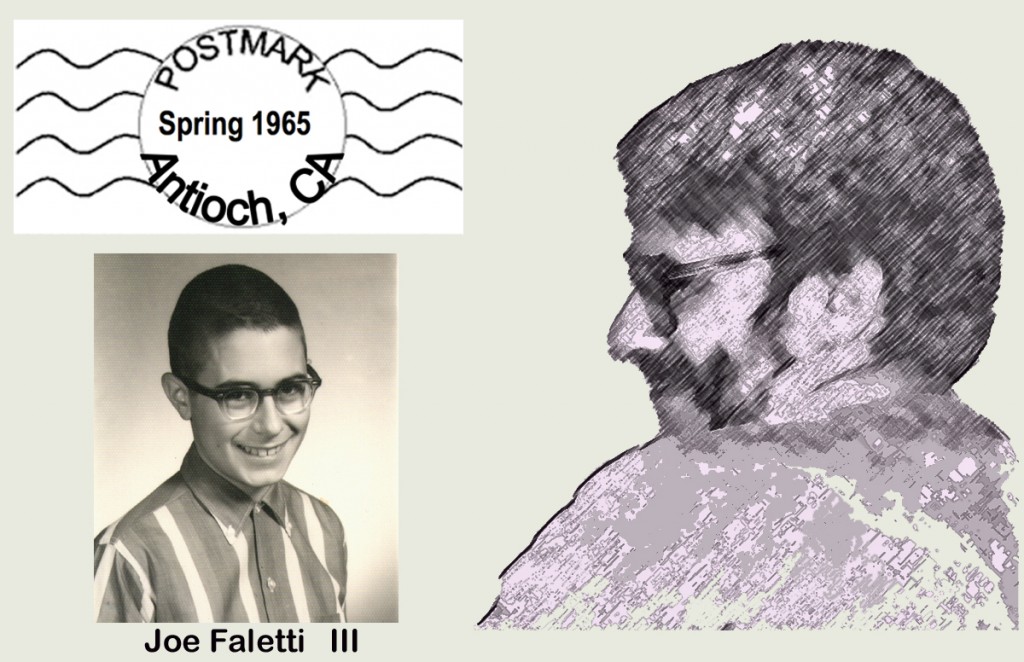 Antioch, CA— I was a scrawny kid in the 50s and 60s, the oldest but thinnest and shortest of six boys. “Wow!” people would say, “six boys — enough for a basketball team (or to play three-on-three)! Or a batter and a full infield.” There were two dozen boys in the neighborhood within six houses either way from home, so we frequently had enough to play baseball for real. However, the diehard baseball fanatics among us sometimes ended up with just two of them — my younger (by 21 months) brother Steve and my uncle Dan (whom many of you know as ‘PapaDan’), only 21 months older, who lived three blocks away. As the only sibling of my mother, he was raised as an only child, but since he lived close enough to walk over to our house, he played with his nephews a lot. He was like an older brother to me and my brothers, except he went home at night and I reverted to being the oldest brother until he returned!
Antioch, CA— I was a scrawny kid in the 50s and 60s, the oldest but thinnest and shortest of six boys. “Wow!” people would say, “six boys — enough for a basketball team (or to play three-on-three)! Or a batter and a full infield.” There were two dozen boys in the neighborhood within six houses either way from home, so we frequently had enough to play baseball for real. However, the diehard baseball fanatics among us sometimes ended up with just two of them — my younger (by 21 months) brother Steve and my uncle Dan (whom many of you know as ‘PapaDan’), only 21 months older, who lived three blocks away. As the only sibling of my mother, he was raised as an only child, but since he lived close enough to walk over to our house, he played with his nephews a lot. He was like an older brother to me and my brothers, except he went home at night and I reverted to being the oldest brother until he returned!
But no, scrawny doesn’t quite capture me — let’s make that wiry. I was skinny but what muscles I had were stronger than most and, in things I cared about, relatively nimble. I played the piano, and was good at untying knots and taking things apart (although not so good at putting them back together). Although Steve was bigger, and we never got into real fist fights, I could cause enough pain with a single knuckle in the shoulder to “keep the peace” if he decided to use his strength and weight against me. I was good enough to hold my own at marbles. And not bad at tether ball, and jacks — more about that in a moment!
But in most things, I was clumsy. In any other kind of sports I was useless, and also not particularly interested. I seldom managed to hit a baseball, although IF I connected well, it went pretty far, but always ended up in right field. Yeah, THAT right field — the one in the song! When I played in the field, of course, I always ended up in right field too. And that song, every word of it, is the story of my defensive baseball career. Well, except for the triumphant catch at the end — that’s fiction! Never happened! Even after I got my own baseball mitt and had half a chance of catching the ball if it came my way.
You’re probably wondering “But if you weren’t good at baseball, and didn’t enjoy it, why did you bother to play? And why are you writing about it now?” Well, I have written in the past about the Tyranny of Baseball (or of Basketball), describing all the ways in which those games dominated major portions of my childhood, dragged along with the family to watch my dad or a brother play lob ball or grasshopper or Babe Ruth until I was old enough to stay home alone or go out alone.
Left to my druthers, I did prefer to spend most of my spare time reading. But when Uncle Dan came over, I wanted to do whatever he had come to do, and that was usually some form of baseball. And even without Dan, my parents would frequently tell me to put the book away and go out and play with the other kids. So I had to do whatever they were doing. And that was usually some kind of baseball.
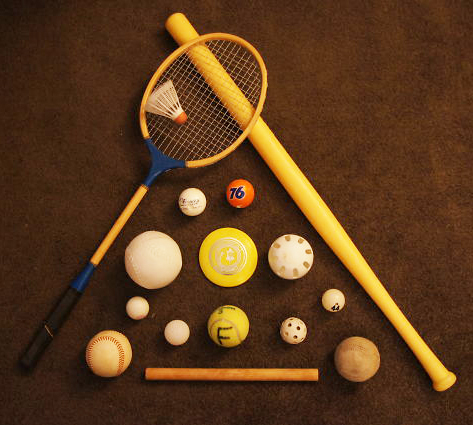
When a 'real' baseball field was not an option, there was no end to the imagination we used to create one in a much smaller space.
Since there wasn’t enough yard to play real baseball, and going to a nearby diamond was usually not an option, they’d invent something that looked like baseball but that fit the room, or the driveway, or the back yard. They’d pitch some kind of ball, maybe solid plastic, maybe a Whiffle ball (holey plastic), maybe a (red) rubber ball, maybe a ping-pong ball, maybe a Styrofoam 76 Union antenna-topper ball — or maybe even a badminton birdie, or a mini-frisbee. And they’d hit it with a wooden baseball bat, or a plastic bat, or a badminton racket or something else you could swing at whatever missile they had chosen. When it was too cold to play outside, they rolled a small rubber ball (loose from its elastic string and wooden paddle) on an old mattress on the floor of the garage and hit it with a foot-long 1-inch dowel.
That’s right! They were committed to baseball and if I wanted to play with them, I was stuck with baseball.
And I could either play along or play alone.
But that wasn’t the only way I was forced to play baseball. In the early grades, as soon as I learned to read chapter books, I would read a book at recess, or just hang around talking with the other sports-incompetents in my class, many of whom also preferred to read at recess. But at some point, around 3rd grade, the teachers decided that I must actually get exercise and interact with other students during recess, so reading was banned. Banned! My fellow book-loving klutzes then decided that since girls were allowed to play jacks at recess, we would join in and play jacks. But that was soon also prohibited and we were forced to play whatever the other boys were playing.
That brings us to dodge ball! Does dodge ball make sense to anyone as a thing kids should be doing? The kids who are biggest and strongest and most nimble get to stand around on the side lines and aim at the klutziest skinniest kids in the middle. Once a klutz is hit, he “gets” to stand on the sidelines and try to aim at the nimblest? No, since the goal is to get back into the middle (I’m not sure why!) even the klutzes will be aiming for the klutzes in the middle. So it’s only the extra-competitive nature of the best athletes that makes them target the athletes in the center. Was there another way to get out of the center? Or was the goal actually to throw the ball over the heads of those in the middle and thus stay out of the middle? I’m not sure. Whatever it was, I wasn’t good at it.
What I was good at was schoolwork, which came as easily to me as baseball and other sports seemed to come to the athletes: Artie, Jim, Larry, and Doug. On the playground, they were the leaders and I routinely failed. In the classroom, I was a leader and they routinely struggled. In those early years, they would sometimes ridicule or even bully me on the playground; but, as we grew, I was frequently asked to tutor them. Gradually, over the years, we reached a truce of sorts, partially through baseball.
Our school’s limited playground space was divided into assigned spaces for each class (and gender), gradually larger for kick ball or dodge ball for the younger grades to ever larger baseball fields. In 5th grade, my class was huge with 20 or more boys, so we actually had at least one extra outfielder. Of course, with 20 boys, 10 per team, at least two of them were the least skillful and so I got to hang out in right field and talk with the other klutz who got chosen last or just before me (no dandelion watching for us!), although we did have to pay attention.
By the 7th grade I observed that the less skilled players were likely to be swinging late, so IF they connected, they would hit toward right field, hence toward the least skillful fielders. This fact lead to my only, only in my life, almost home run! I managed one memorable day to connect solidly with the ball and send it zooming over the head of the fellow-inept in right field. He had to run after it, catch up, stop it, and throw it back a long way into the infield. I headed off around the bases, not for a moment expecting to make it home. As I approached third base the klutz in right field had stopped the ball and had thrown it toward home; but Artie, the third base coach and one of our best ball players, waved me toward home. I could see in his face that he was pleased with my achievement and believed that I could score. When I stopped at third, satisfied with the joy of my life’s first and only triple, my teammates, especially Artie, were gravely disappointed. It was my big chance and Artie was pulling for me. When I came up short, everyone thought I had blown it.
I thought I had triumphed.
Of course, I had slightly more experience than Artie in being caught between the third baseman and catcher, after having gone too far past third when being driven round the bases after a single by subsequent hitters — note that the worst players bat last in the lineup, so if we make it on base, we are the ones unfortunate enough to be driven around the bases by the much more capable, and faster, baseball stars. If we were slow, or timid, it is likely that the faster runners behind us would catch up and end up caught between bases. So somehow, regardless of how I ever reached third base, I was very likely to disappoint my teammates. Sigh!
So that was my almost-moment in the sun! My onlyest triple that could have been my onlyest home run if I’d trusted Artie to know what he was doing, which of course he did!
But the moment of light in my relationships with Artie and the other athletes came to us all gradually. I learned patience as I watched them work hard and struggle with math or diagramming sentences. And they learned patience as they watched me struggle while they tried to coach me to become a better ballplayer. I think bringing a mitt with me may have showed them some measure of commitment. We gradually recognized that each person had some things that came easier and some things that didn’t come very well at all, regardless of how much effort we put in. So eventually, Artie and I accepted each other for who we were.
In the 40+ years since high school, we’ve met at reunions and parish functions and became good friends. Artie went on to become a policeman, then briefly a mortician(!), then back to the police force to mentor and train new recruits, which he does today. But I think that our shared moments in the sun — one basking in the sun and the other struggling under its glare — have contributed a bit of wisdom, patience, and acceptance to both of us. ![]()
Joe_Sun_Moment_FINAL_Aug2011.pdf
Filed under: Baseball,Family Stories,Who We Are | |2 Comments
A Moment in the Sun
 Just to hit the ball and touch ’em all
Just to hit the ball and touch ’em all
A moment in the sun;
. . . it’s gone and you can tell that one goodbye.
— John Fogerty, Centerfield, 1985
* * * * * * * * *
I grew up as one of those elementary-school kids who were labeled ‘uncoordinated.’ Since baseball was the most important measure of a boy’s worth in the fifth grade, boys were assigned a place in one of two important classes of people. Either we were:
1) ‘cool’ — that is, among those who could successfully play baseball
or we were
2) ‘uncoordinated’ (aka ‘not cool’) — couldn’t catch, couldn’t throw, couldn’t hit a baseball.
By the Spring of 1962 at the end of the 6th grade, I was well established as a member of that second class.
For me, that membership was manifest in a well-defined ritual that took place on the infield of an all-dirt baseball field with a grove of almond trees behind left field and the back fences of the houses on 13th Street behind right. When it was time to pick teams, two kids who were identified by acclamation to be the best players were the captains. Nobody had to say so, there was no need for an election, it was known intuitively by everyone in the 6th grade who were the best two. The most important reason to make them the captains, by the way, was to ensure that they didn’t end up on the same team — which would have rendered that team unbeatable. The two captains would take turns naming the players who would be on their team. The best hitters went first, a pitcher who could get the ball over the plate had to be selected early, and a shortstop and first baseman were essential. I knew when I would be picked and the only suspense was to wait to find out which captain would be stuck with me.
At that stage of my life it wasn’t a terrible thing to be a lower-class kid on the ball field. After school, while the ‘first group’ of regular kids went off to little-league practice, I carried home the leather briefcase my Dad had given me containing a book of stories by Mark Twain and other books my Dad bought me about other times and other places. I was intimidated by the prospect of playing sports and didn’t see why I would want all of that pressure and embarrassment. Reading was safer. But I wasn’t a total loss, I was content, even thrilled to enjoy baseball as a spectator. Early in the 6th grade my brother-in-law, Joe, took me and my nephews to our first Giants game at Candlestick Park and I was immediately smitten. From that time on, I became a regular listener to Russ Hodges and Lon Simmons as they brought the Giants to life on my transistor radio. I was a first-class baseball fan, even though I was definitely not a player.
Everything Changes
During the summer and fall of 1962, two very big things happened in my life:
1) The Giants won the National League Pennant
and
2) I grew six inches.
My heroes, Willie Mays, Willie McCovey, Orlando Cepeda, Juan Marichal, Jim Davenport, and the rest of the Giants were everybody’s heroes and I was content to be part of that. It was fun and there were no expectations to being a baseball fan. It was easy. As long as I had my books and my transistor radio, life was good. But then, something happened that changed everything and — like most big changes — at the moment it was happening, it was scary!
One afternoon during the first week of basketball season — you may ask, what does basketball have to do with baseball? and I’ll get to that — I walked out of my school building happily carrying my leather briefcase with my books when Gene Banti, who unbeknownst to me was the 7th and 8th grade basketball coach, passed me on his way into the building. Without any introductions, he stopped dead in his tracks said, “What grade are YOU in?” I didn’t like his tone of voice.
“I’m in the 7th grade.”
“You’re tall!” I felt like he had accused me of something. “You need to be on the basketball team. Practice is Wednesday after school and I want you out there.” This was turning out to be a very uncomfortable moment in the bright afternoon sun. I didn’t like where this conversation was going.
“No . . . I can’t.” I made up some excuse about Wednesday, which apparently was unsatisfactory.
“Oh, no. I’ll speak to Sister Bernadette about it. You’ll be out there on Wednesday.” That’s how Junior High basketball coaches talked in the early sixties.
Sure enough, through the awesome power and influence of Sister Bernadette (she called my mother), I found myself on the basketball court on Wednesday afternoon. I didn’t like it at all and the other players — those whose membership in the aforementioned ‘first group’ had been earned by their baseball abilities — seemed to find it amusing. The coach was designing a new offense around this new tall player and teaching me how to play zone defense. “All you have to do is stand up straight, put your hands up, and stay in this part of the court. When the other team shoots, all you have to do is jump, grab the ball, and throw it to Gary. He’ll take it from there.”
To my surprise, I found that I could do those things fairly well. Dribbling and shooting were a bit of a mystery at first, but I found that I could at least carry out my limited assignment without embarrassing myself too much. A kid, I’ll call him Eddie Summers, who had lost his place on the starting five when I showed up, didn’t like me at all and did his best to ridicule everything I did; but after the first couple of times I blocked his shot, he seemed to quiet down.
So, one thing led to another and I finished the basketball season on the starting five, got a bunch of rebounds, and helped Gary score a lot of points because of all the defensive rebounds I hurled down the court to him. One day, the school principal, Sister Bernadette. came up to me at recess and handed me a basketball. She said, “the coach tells me you can shoot and get rebounds, but he says that when you try to dribble, you embarrass both of us. So, your assignment is to take this basketball every day at the morning recess and dribble up and down the convent driveway until the coach tells me you can dribble.” One thing led to another and all of that practice made a difference. More than the dribbling, Sister Bernadette taught me two things: that basketball mattered and so did I. Her influence caused me to embark on a long career as a basketball player and a coach. Heck, my sons turned out to be better basketball players than I ever was. Sister Bernadette started all of that. But, I digress. Back to another important day, back to the playground …
Most of all, I began to feel like I might have become a regular person. I wasn’t sure, but I figured it was possible; so I looked for an opportunity to find out. Unfortunately, basketball season came to an end and I found myself standing on the baseball diamond in front of the two captains, waiting to be picked. I felt I had distinguished myself as a passable basketball player (if only because I was now a tall person); and I wondered if my status as a ‘potential regular kid’ would transfer from the basketball court to the baseball field, where it mattered. I figured the ritual of ‘the picking of teams’ might provide the evidence of that transformation — one way or the other.
The Test
Sure enough, it didn’t take long. Michael Savage, one of the acclaimed captains, picked me NOT LAST — not early, mind you, that would have been too much of a fantasy, but getting picked NOT LAST made me feel like . . . a regular kid. So, with a grin on my face that I couldn’t hide, I came up to bat with lots of confidence. The bad news was that I looked at the pitcher and found that it was Eddie, the kid who got pushed off the starting five and onto the bench when I arrived on the basketball team. Eddie immediately dashed my optimism when he said, loud enough for everyone to hear: “Look, this isn’t basketball. Being tall isn’t gonna get you anything on this field. You still can’t hit.”
Well, maybe I expected too much to think I would be accepted as a regular kid just because I was tall and could play a little basketball. With those few words, Eddie had pulled a plug and drained the confidence right out of me. But this time I felt something new — I WANTED to be accepted; I thought I deserved it, so I was mad. Really mad. I hadn’t fully realized until just that moment, but basketball taught me that there was more to life than books and that it was possible to be treated like a regular kid, with all of the rights and privileges that went with that status. As I stood in the batter’s box, that kid on the pitcher’s mound stood between me and the respect that a regular kid deserved, respect that I had tasted and I suddenly wanted more. I knew that he was right about one thing: baseball was the real test of a boy’s status and I had to prove myself all over again or all of that ‘regular kid” stuff would be washed away with a few futile swings of a bat — right here and now in front of all these people. As his first pitch came across the plate about shoulder high, that baseball BECAME the smirk on Eddie’s face and I hated it. I transferred all of those new feelings into the bat, and swung as hard as I could.
I hit the damn thing into the trees. It was an accident, honest. It just happened. But it was supposed to happen. I rounded the bases and never looked back. From that day forward, nothing would ever be the same.
Filed under: Baseball,Family Stories,Who We Are | |5 Comments
Why Do I Love to Travel? — Three Gifts From My Father
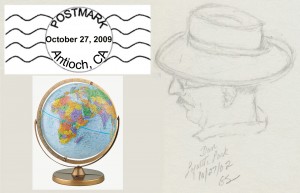
“It seems to me that once in your life, before you die, you ought to see a country where they don’t speak English and they don’t even want to.”
— Mrs. Gibbs, Our Town, Thornton Wilder
∞ ∞ ∞ ∞ ∞ ∞ ∞ ∞ ∞
I’ve been asked,”How did you get to be so interested in travel? Where did it come from?” I trace my excitement for travel to three gifts from my father.
Gift Number One
I remember one Christmas morning when I was young enough to have written a letter to Santa Claus, I found a world globe under the tree. It wasn’t a great surprise, because my letter had specified that I wanted “a revolving globe.” It was almost two feet high and it rotated on a tilted axis, with a metal stand — just as I had expected. But as I lay on the floor examining the different-colored shapes and large expanses of blue ocean, some surprises began to emerge.
First, I asked my Dad, “Where are we?” Since last Christmas when I got my first big-boy bicycle, I observed that my hometown was huge. I could ride my bike for a half hour and not even get to 18th street. So, I was surprised when my Dad said, “Our town is so small you can’t even see it.” When he showed me that our town was just a half an inch from San Francisco and that the longest trip I had ever taken — to Disneyland — was only three inches south of us, I was stunned. I looked back at my globe with new respect and I thought, “This is more serious than I realized.”
Suddenly, I was full of questions: “Where are the New York Yankees?” “Where does President Eisenhower live?” Then he opened my eyes to a subject I had not thought of before when he said, “Let me show you where my father came from.” To my amazement, he turned my globe around to the other side and pointed to an orange shape that looked like a boot. “Italy. Reggio di Calabria. Down here near the toe.” I looked at the ‘boot,’ back up at him, then down at the ‘toe.’ I remember wanting to ask more questions, but didn’t know what to ask.
As time went on, my globe helped answer some more complicated questions. As a kid, I noticed ‘old people’ like my grandparents talked in words that I couldn’t understand. I also noticed that some of the ‘middle-aged’ people in the family seemed to understand those strange words, but still spoke to me in the words I understood. Nobody my age understood this way of speaking. So, I drew a logical conclusion: when people got old, they started speaking in a strange new way — “old-people talk,” I called it. I figured that when you get to be “half-way old,” like my parents, you began to talk funny to older people but hadn’t completely lost the “right way” of talking to younger people. I figured that when my parents got “old,” they would undergo the complete transformation that I observed had happened to my grandparents.
When my Dad overheard me explaining this “fact” to one of my nephews, he took me over to the globe and explained that grandma and grandpa spoke “Italian.” He spun the globe and showed me; “People who grew up here, in Italy, spoke Italian from the time they were little. When grandma and grandpa came to America they had a hard time learning to speak English like we do here.”
Then came the really interesting part. “Here in America,” he told me, “We speak English because many of the people who came here a long time ago came from England.” He spun the globe again. “Right here.” The different colors I had wondered about on my globe all turned out to be different countries where they spoke different languages. What a revelation! “People from France spoke French. People from Spain, the yellow one there, spoke Spanish. People from Portugal, like Father Perdigon from church, spoke Portuguese.” And so on.
In the year between that Christmas and the next one, my questions led to more answers; and a second gift from my father dramatically increased my interest in spinning the globe.
Gift Number Two
That year I found under the tree a Viewmaster Viewer. It was a thing that looked like a pair of binoculars only you inserted a three-inch cardboard disk into it before you put it up to your eyes. Each disk contained about twenty color slides. When you pulled the handle, the disk rotated to the next picture. The disks that came with it were labeled “Egypt,” “England, “ “France,” “Italy,” and “China.” A little booklet explained the pictures. This gift taught me about leaning towers, pyramids, and Great Walls from all around the globe. Looking back, the pictures made the countries seem bigger and more interesting and the globe seemed much smaller.
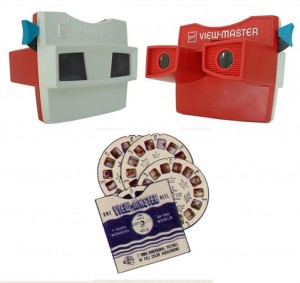
I learned something more when I started showing my Dad the pictures in the Viewmaster. I showed him the leaning tower and asked, “Was that tower leaning like that when you were there?”
“I’ve never been there,” he said without taking his eyes from the Viewmaster. “But you need to go there someday.” As we talked about the other pictures — the pyramids, the Great Wall, Big Ben, the Eifel Tower — I came to realize that he had never been to any of the countries he had introduced me to. “But you need to go there someday,” he said; and he said it more than once.
Gift Number Three
This gift was not at Christmas. It was during the summer. Perhaps I had whined about “nothing to do around here.” Or maybe my Dad said something like, “What do you do all day?” I don’t remember. What I do remember is that one day he brought home a booklet: Collecting Stamps for Fun and Profit.” (No fooling.) He told me that all the countries on my globe publish their own postage stamps to charge people for sending letters and packages. He showed me in the booklet that the words on the stamps were written in the language of that country and that they put pictures on them illustrating the people, places, and events that were important to them.
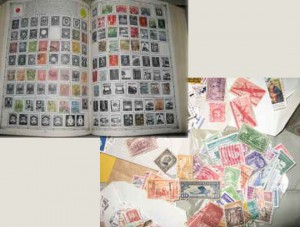
When he took me to the hobby store — one of the customers of his insurance agency — and showed me the stamp collecting albums with pictures of all the stamps you can collect from different countries, I was hooked. I brought home the “Regent” stamp album (I still have it), another book called The Stamp Finder to identify the country a stamp was from, a magnifying glass, and my first package of assorted stamps from around the world. With all of that, I learned that other countries called themselves names different from what we call them — Francais, España, にっぽん, Italia. It didn’t take long before I had developed favorites and became determined that “I need to go there someday.”
∞ ∞ ∞ ∞ ∞ ∞ ∞ ∞ ∞
So, whoooooosh, fast-forward to today and I can look back on those three gifts from my Dad as the source of my intense desire to travel to places “where they don’t speak English and don’t even want to.” As a result, I have been to Italy, France, Japan, The United Kingdom, Austria, yes, and the United States, and I still hunger for more.
Thanks Dad. ![]()
P.S. Yes, There Was Another Gift
On my tenth birthday, my father gave me a telescope and a 3’ x 4’ poster to hang on my wall. It was a color drawing of the Solar System, showing nine planets, their distances from the Sun, and labels with all kinds of facts about each planet. Where this gift will lead has not yet been determined— but I suspect that will be for my grandchildren to decide.
Filed under: Family Stories,Travel | |10 Comments
||
